APPLE ENGINEER RICHARD HUIZAR
LATINO FROM SAN MARCOS FIGHTS HIS WAY TO THE TOP

Latino de San Marcos diseña el Apple Vision Pro
LATINO CULTURAL EVENTS
ACTUACIONES Y BAILES CULTURALES
FINANCIAL EDUCATION IN 4 EASY STEPS
CUATRO PASOS
HACIA LA EDUCACIÓN FINANCIERA
WHAT ARE THE PRIMARIES?

COMPRENDER
LAS ELECCIONES
PRIMARIAS
BILINGÜE GRATIS
CELEBRATE HISPANIC HERITAGE MONTH IN THE NORTH COUNTY CELEBREN EL MES DE LA HERENCIA HISPANA
CHANGES TO MEDI-CAL: DON’T LOSE YOUR COVERAGE
CAMBIOS A MEDI-CAL: NO PIERDAN SU COBERTURA
EDUCATION, HEALTH, SERVICES & MORE EDUCACIÓN, SALUD, SERVICIOS Y MÁS
SEPTEMBER 2023 PUBLIC SERVICE JOURNALISM ON HEALTH, EDUCATION, CIVIC ENGAGEMENT, & FINANIAL EMPOWERMENT
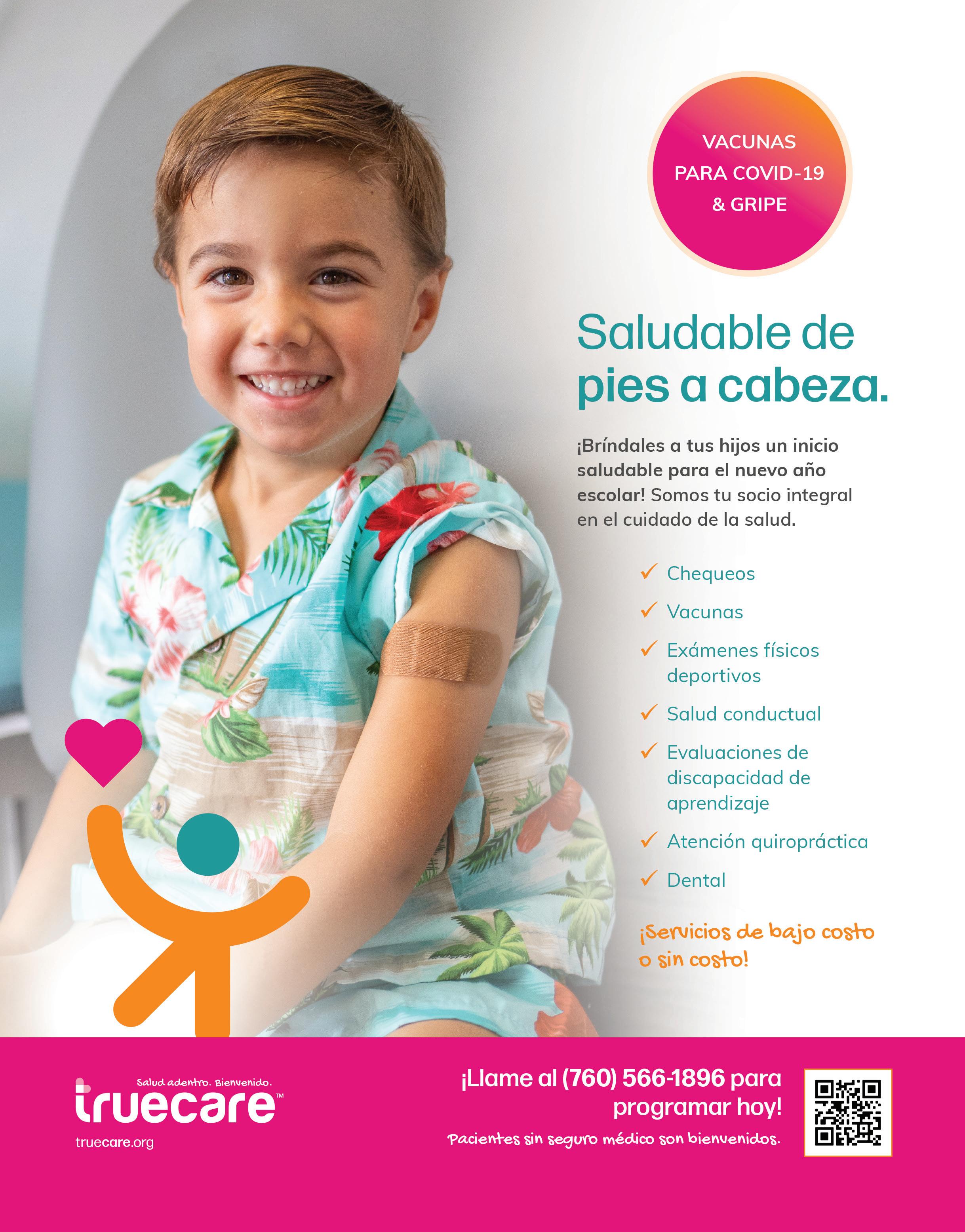

EDUCATION EDUCACIÓN
Free Books / Libros Gratis
Through ELF’s Education Begins in the Home Program
Saturday, September 16, 11 am - 3 pm
Fiestas Patrias Chavez Center
605 San Diego St., Oceanside
Thursday, September 28, 9 am–12:30 pm
Fallbrook Food Pantry
140 N. Brandon Rd., Fallbrook
Universidad
Popular
Citizenship & Civic Education Class
Ciudadanía y Educación Cívica
Every Tuesday
Todos los martes
English: 5–6 pm.
Español: 6–7 pm
San Marcos Elementary Multipurpose Room
- 1 Tiger Way, San Marcos, CA 92069
- 760-659-0109
- info@unipopular.org
Volume 3, Issue 3.44
On the cover: Richard Gabriel Huizar grew up in San Marcos and now is an Apple engineer. Photo by Gabriel Liendo, gabrielliendo.com
Scan to subscribe to NCI and see past issues: North County Informador is a digital weekly and monthly ePub or print issue.
Empowering Latino Futures presents the North County Informador Team www.NorthCountyInformador
- Editor: Melanie Slone, PhD editor@NorthCountyInformador.com
- Art Director: María Fernanda Álvarez
- Webmaster: Ximena Esquivel
- Education Begins in the Home Program Director: Edward Becerra
- Community Engagement Coordinator: Martha Zamora
- ELF Office Coordinator: Melissa Lopez
- ELF Office Assistant: Galilea Flores Hernandez
- Tech Support: Marc Perez
- Tech Intern: Daniel Perez
- Sacramento Coordinator: Rene Aguilera
- Publisher: Kirk Whisler
To advertise: Melissa Lopez, melissaL1632@gmail.com, 760-458-7568
North County Informador Advisory Board
PASS AmeriCorps is currently looking for AmeriCorps Service Members for the 2023–24 school year (program start date September 1, 2023–end date June 30, 2024, for a 10 month/1700hour contract).
Program benefits and opportunities:
$2,000–$2,250 monthly living allowance
$6,895.00 Segal Education Award for Full-time Service Completion
$3,105.00 Segal Educational Award (for 1700-hour contract)
Medical, dental, and vision coverage
Professional development training
Real world experience and networking opportunities in public school system, education, social work, and counseling fields Make a difference in the lives of children
PASS AmeriCorps está buscando a miembros de servicio AmeriCorps para el año escolar 2023–2024 (del 1 de septiembre de 2023 al 30 de junio de 2024, para un contrato de 10 meses/1700 horas).
Beneficios y oportunidades del programa
$2,000–$2,250 mensuales
$6,895.00 Premio Segal Education por Realizar Servicio de Tiempo Completo
$3,105.00 Premio Educativo
Segal Educational (para contrato de 1700 horas)
Seguro médico, dental y de visión Capacitación de desarrollo profesional
Experiencia y oportunidades de networking en el sistema escolar público, educación, trabajo social y consejería
Hagan una diferencia en la vida de los niños/as
Edward Becerra, Education Begins in the Home; Jacqueline “Kiki” Bispo, Vista Unified School District; Monica Martinez, North County Philanthropy Council; Alejandro Tamayo, San Diego County Office of Education; Dr. Rafe Edward Trickey, Jr, North San Diego County Promise; Leticia Vera, TrueCare Please email editor@NorthCountyInformador.com if you are interested in being a part of this effort.
Nonprofits, publish content through us. We accept English, Spanish, or both.
Civic Engagement, Community Services, Cultural Events, Education, Financial Empowerment, Food Security, Government Services, Health Services, Immigration Services, Information on Access to Essential Services, Community Events
Send material to: editor@northcountyinformador.com
All materials are copyrighted by Empowering Latino Futures, a 501c3 nonprofit and the parent organization of North County Informador.
Empowering Latino Futures Board

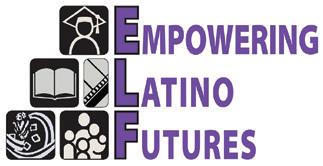
Edward James Olmos, Chair Kirk Whisler, Presdient
Katharine A. Diaz, Author VP
Andres Tobar, Education VP Lisa Montes, Secretary Dennis Garcia, Treasurer
BOARD MEMBERS
Julia Abrantes, Edward Becerra, Victoria Chavez, Norma Jasso, Esther Reyes Jones, Leticia Ordaz
ELF Emeritus Board Members
Nora de Hoyos Comstock, PhD; Dennis Hernandez; Zeke Montes; Ambassador Julian Nava; Jesus Nieto, PhD; Martin Valdez
http://www.sdcoe.net/pass-americorps

https://www.flipsnack.com/passamericorps2021/pass-americorps-programresources-ezine.html
Scan to visit ELF


4 SEPTEMBER 2023 WWW.NORTHCOUNTYINFORMADOR.COM
HISPANIC HERITAGE
The 30 days from September 15 to October 15 have been designated as ‘Hispanic Heritage Month’. What does that mean to us? We have talked with community leaders from the North County about what this month means to them, how they are working to boost Latinos all year long, and what stories and traditions they can share. Plus, we talked to Richard Huizar, a Latino who grew up in San Marcos, where he overcame many obstacles on his path to MIT and his job as a prototype engineer with Apple. His story encapsulates the customs, drive, hope, and accomplishments so many Latinos are celebrating this month.
- Write the editor: editor@NorthCountyInformador.com
Cover Feature
Richard Huizar: MIT Grad, Apple Engineer Latino student from San Marcos defies roadblocks to success
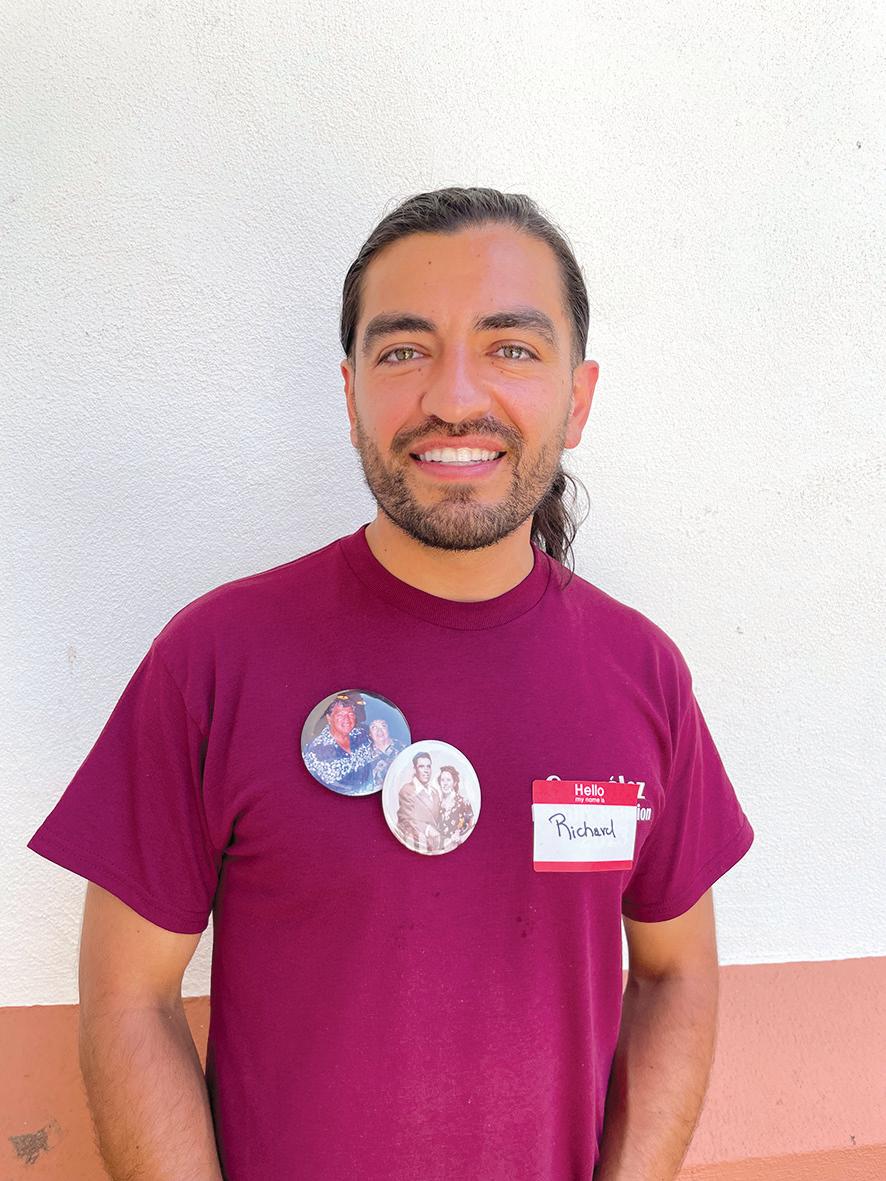
Artículo de portada
Richard Huizar: Graduado de MIT, ingeniero en Apple
Estudiante latino de San Marcos supera obstáculos para lograr el éxito
LA HERENCIA HISPANA

Los 30 días del 15 de septiembre al 15 de octubre se han designado como el ‘Mes de la Herencia Hispana’. ¿Qué significa para nosotros? Hemos platicado con líderes comunitarios del norte del condado de San Diego sobre lo que este mes les representa, cómo están trabajando para impulsar a los latinos durante todo el año, y qué historias y tradiciones pueden compartirnos. Además, hablamos con Richard Huizar, un latino que creció en San Marcos, donde superó muchos obstáculos en su camino hacia MIT y su empleo como ingeniero de prototipos con Apple. Su trayectoria encapsula las costumbres, el impulso, la esperanza y los logros que tantos latinos celebran este mes.
- Escriban al editor: Editor@NorthCountyInformador.com
WWW.NORTHCOUNTYINFORMADOR.COM 5 SEPTEMBER 2023 Feature Celebrating Hispanic Heritage Month in the North County Events Ballet folklórico, cultural activities Civic Engagement What Are the Primaries? Financial Empowerment Celebrating the Latino Community with Financial Education Health Breast Milk Drive; Medi-Cal coverage Services Legal resources, food distribution, low-cost Internet Artículo Se celebra el mes de la Herencia Hispana en el norte del condado Actividades Ballet folklórico, actividades culturales Civismo
son las elecciones primarias? Empoderamiento financiero Celebremos a la comunidad latina con educación financiera Salud Recolecta de lecha materna / Cobertura de Medi-Cal Servicios Recursos legales, distribución de alimentos, Internet a bajo costo IN THIS ISSUE 6 12 19 21 20 22
¿Qué
EN ESTE NÚMERO
14
Celebrating HISPANIC HERITAGE MONTH IN THE NORTH COUNTY
After hundreds of Mexicans fled the Revolution in the 1910s, arriving at tent cities in Carlsbad, Pablo Ramirez built a house on the southwest corner of Walnut Avenue and Second Street, now called Roosevelt Street, in 1918. On that corner, in 1943, a family set up Lola’s Seven-Up Market and Mexican Deli to serve the people of Carlsbad, the oldest operating business in the city.
Sisters Ofie Escobedo, Connie Trejo, and Frances Jauregui took over the Juare’s store founded by their parents, Reyes and Dolores (Lola) Jauregui in the mid1980s, and their family continues to honor the site today with a cultural museum.

Ofie, who passed away November 19, 2022, made it her life mission to preserve this history within the walls of the “Barrio” Museum on the southeast corner of the intersection; on July 10, 2009, the Carlsbad Historical Preservation Commission and Lola’s Seven-Up Market and Mexican Deli were celebrated throughout San Diego County for Heart of the Barrio Day.
This story is just one of many honored during Hispanic Heritage Month celebrations in North County San Diego.
The Designation
Hispanic Heritage Month is sometimes called Latino Heritage Month, Latinx Heritage Month, ChicanX Heritage Month, or other names. But the important point is that September 15–October 15 has been designated for people in the United States, especially the educational community, to observe the Latino culture and its contributions to our country with appropriate ceremonies and activities.
The US Congress first adopted National Hispanic Heritage Week in 1968, and in 1988, it was expanded to a month-long period. The 30-day timespan coincides with the celebration of Independence Day in many Latin American countries, including Costa Rica, El Salvador, Guatemala, Honduras, Nicaragua, Mexico, and Chile.
Many of our readers and community leaders spend much of their time focusing on bolstering Latino success and reaching out to the community. They are on the front lines building strong futures for families.
Lisa Montes, the curator of the Solana Beach Heritage Museum, makes sure local kids visit to learn
about their roots. She also participates in cultural celebrations such as Día de Muertos and the Christmas posadas.
Also from Solana Beach, Cipriana Martínez González fought for La Colonia Community Park in the 1970s, where today the tiled Tree of Life wall lists the names of the first Mexican families who settled there.
Community Pillars
Other community leaders have fought for a place for Latinos in education and employment circles. In San Marcos, Tony Contreras and John Valdez were trailblazers in bringing the Chicano Student Movement of Atzlán (MEChA) to North County schools and making sure students would learn about the history, culture, and contributions of Mexican Americans in our area.
John Valdez also spearheaded the multicultural studies program at Palomar College, fought for the placement of Latino-themed murals on the campus, and directed the publishing of the book ‘En Aztlán’. John remembers his struggle to create the Chicano Studies program in San Diego. Today, he is proud to see Dr. Star Rivera-Lacey as the institution’s first Latina president.
Dr. Rivera-Lacey is aware of how much that representation matters. “I’m looking at the student population; does it reflect the community population?” she asks as she fights to remove the barriers to success for students.
MiraCosta College also helps Latino students preserve their culture. For example, Beatriz Palmer, Program Manager, Service Learning & Volunteer Center,
6 SEPTEMBER 2023 WWW.NORTHCOUNTYINFORMADOR.COM
Juare’s Market is now the Barrio Museum in Carlsbad. (Martha Zamora)
who self-identifies as a Black Indigenous Latina, believes education helps people understand their identity and history without rejecting it or leaving their community behind. She tells her story and encourages others to do the same. “You have to own your greatness. You have it. You just have to own it,” she says.
Dra. Beatriz Villarreal is another community leader who talks to parents about drugs, gangs, and other issues to make sure strong, healthy families are created and protected. Her presentations in Spanish are culturally sensitive, which helps Latinos integrate into their communities while holding on to identity and culture.
Meanwhile, Oscarin Ortega fights to change stereotypes about Latinos within organizations that offer services. “We’re honest people, we’re hardworking people. We’re educated…we have tons of experience. We come with great culture, traditions. We have manners. We have ethics…are family-oriented,” he says.
Artists Celebrate Hispanic Culture
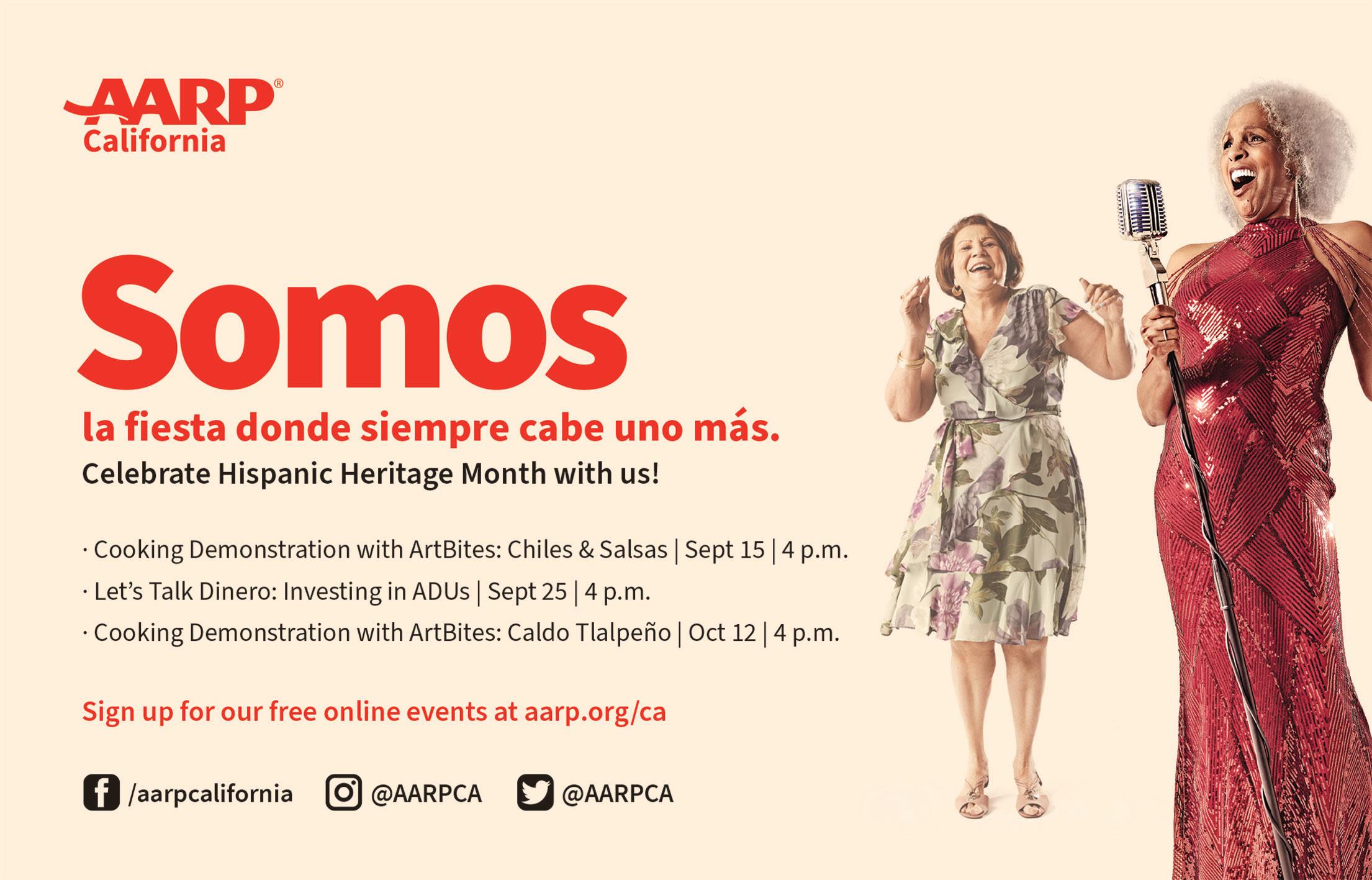
As one of the most powerful, concentrated forms of cultural manifestations, art serves as a vessel of expression and celebration.
The author Reyna Grande has told us she believes literature can serve as a bridge to keep us connected.
Her stories of immigration can help communities “feel connected, feel celebrated, feel seen,” she says.
Josefina Lopez, the author and scriptwriter known best for ‘Real Women Have Curves’ says, “I choose to celebrate my culture in the way I live my life…We have to embrace all the beautiful things about our culture that inspire us, that make us whole.”
Victor Villaseñor, the author of ‘Rain of Gold’ and other works, who lives in Oceanside, encourages everyone to write their family history. “Interview parents, grandparents, aunts, and uncles. Write your family Bible,” he says. Not only is it a way to preserve culture but also to connect with others, with all of humanity, he notes.
For José Jaimes, the director of Tierra Caliente Academy, knowing where we come from helps us cultivate future leaders. He believes that passion for culture begins in the home, but art like ballet folklórico, which he teaches, can show them where they come from and provide some discipline. “It takes us as a community to make sure that we nurture them. We teach them. We guide them,” he adds.
Last year the actor Cheech Marin gave his push for the preservation of Latino culture through art by showing off his collection at The Cheech, in the Riverside Art Museum, “the first museum in the world dedicated to Chicano Art,” he says.
Take Part in Some 2023 Hispanic Heritage Events
What does Hispanic Heritage Month mean to you?
“It is the opportunity for us to stop and intentionally reflect on, and celebrate, all the great contributions Latinos have made to everything around us! We are woven into the fabric of this beautiful country!
–Dr. Star Rivera-Lacey, Palomar College President/Superintendent
“Hispanic Heritage Month is a way to celebrate the present, learn from the past, and cultivate for the future. It educates us about identity—being part of something, belonging to something. It reminds us that when there’s a will, there’s a way. There were other great leaders before us that changed the world, and no matter the current barriers, it is in our blood to make history.
–Jose Jaimes, Executive Director, Tierra Caliente Academy of Arts
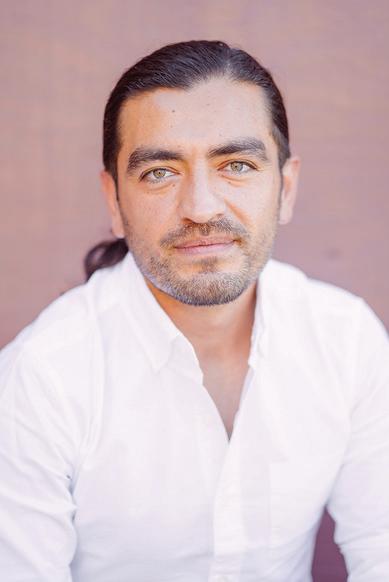

“To celebrate Hispanic Heritage is to recognize the hard work and sacrifices of our ancestors, the positive impact Latinos have today, and the continued progress we will make together in the future.
–Adriana Brunner, Director of Business Development, MyPoint Credit Union
“For me, it’s really about growth. One of my grandparents grew up on an orange field, picking oranges, and the other one worked in construction doing steel work. My parents were better off than my grandparents, but they still lived paycheck-to-paycheck. They still had these huge hardships. Now, I have financial freedom not to have to live paycheck-to-paycheck. It’s feeling grateful
for what they did because they made sacrifices that led me here today. And the same thing moving forward, with my future kids. I know my grandparents’ sacrifice eventually led to that as well.
–Richard Huizar, prototype engineer at Apple
The Cheech en el Riverside Art Museum muestra la colección del actor Cheech Marin, que incluye esta pieza de Judithe Hernández, titulada ‘Juárez Quinceañera’.

Grito de Independencia
Friday, September 15, 9 p.m.
With Tierra Caliente Academy
California Center for the Arts
340 N. Escondido Blvd. 92025
Pledge to the Mexican flag, Mexican national anthem, Independence Day ‘Shout’
El Grito de México en San Diego
Saturday, September 16, 5–9 p.m.
Mexican Consulate in San Diego
1549 India Street
Ballet Folklorico, live regional music, mariachi, and the official “Grito de México” by San Diego’s Cónsul General Carlos González Gutiérrez.
Fiestas Patrias
Saturday, September 16, 11 a.m.–3 p.m.
Chavez Community Resource Center
605 San Diego St., Oceanside
Escondido Herencia Mexicana Festival
Sunday, September 17, 11a.m.–5 p.m.
Grape Day Park, 321 N. Broadway, Escondido
Ballet Folklórico from the 32 Mexican states
Hispanic-Serving Institutions
The San Diego North County’s two community colleges, MiraCosta and Palomar, are designated as HispanicServing Institutions (HSIs). An HSI has an enrollment of students that is at least 25 percent “Hispanic,” the colleges are eligible for federal grants.
California has the most HSIs of any state, which means two things, says Edward Becerra, the director of Education Begins in the Home, “one, more Latinos are attending college; and two, the colleges can use those additional monies to create programs specific for Latino students.”
Palomar College’s Superintendent/President, Dr. Star Rivera-Lacey, joined the Board of Directors of the National Community College Hispanic Council (NCCHC) on September 16, 2022. The Council prepares Hispanic leaders for community and technical colleges across the country.


Cal State San Marcos is also an HSI, with 48% Latino students in Fall 2020, according to the US Department of Education, and is home to the National.
MiraCosta: https://library.miracosta.edu/latinx
Palomar: https://www.palomar.edu/hsi/resources/ https://www.palomar.edu/alass/
Cal State San Marcos: https://www.csusm.edu/ centrolatino/index.html
8 SEPTEMBER 2023
Celebrando el mes de LA HERENCIA HISPANA EN EL NORTE DEL CONDADO
Cuando cientos de mexicanos huyeron de la Revolución en la década de 1910, llegaron a ciudades de tiendas en Carlsbad; Pablo Ramírez construyó su casa en la esquina sudoeste de la Avenida Walnut y la Calle Segunda, hoy llamada la Calle Roosevelt, en 1918. Sobre esta esquina, en 1943, una familia estableció el Mercado Seven-Up de Lola y Deli Mexicano para servir a la gente de Carlsbad; es el negocio más longevo de la ciudad.
A mediados de la década de 1980, las hermanas Ofie Escobedo, Connie Trejo y Frances Jauregui tomaron las riendas de la tienda Juare’s fundada por sus padres, Reyes y Dolores (Lola) Jauregui, y la familia sigue honrando el sitio hoy como un museo cultural.
La misión de vida de Ofie, quien falleció el 19 de noviembre de 2022, fue conservar esta historia dentro de las paredes del Museo del Barrio en la esquina sudeste del cruce; el 10 de julio de 2009, la Comisión de Conservación Histórica de Carlsbad y el Mercado Seven-Up de Lola y Deli Mexicano se festejaron por todo el Condado de San Diego como parte del Día del Corazón del Barrio.
Esta historia es una de muchas honradas durante el mes de la Herencia Hispana en el norte del condado de San Diego.
Un mes designado
Al Mes de la Herencia Hispana también se le llama el Mes de la Herencia Latina, el Mes de la Herencia Latinx, Chicanx u otras denominaciones. Pero el punto es que, los 30 días del 15 de septiembre al 15 de octubre se han designado en Estados Unidos, sobre todo entre la comunidad educativa, como un momento para celebrar la cultura latina y sus contribuciones a este país, con las ceremonias y actividades correspondientes.
El Congreso de Estados Unidos aprobó la Semana de la Herencia Hispana en 1968, y en 1988, se expandió a un periodo de un mes, 30 días que coinciden con la conmemoración de la independencia en muchos países latinoamericanos, entre estos Costa Rica, El Salvador, Guatemala, Honduras, Nicaragua, México y Chile.
Muchos de nuestros lectores y líderes comunitarios dedican gran parte de su tiempo a reafirmar el éxito latino y a conectarse con la comunidad. Están al frente, construyendo un futuro fuerte para las familias.
Lisa Montes, la curadora del Museo de la Herencia en Solana Beach, se asegura de que los niños locales visiten para aprender sobre sus raíces. También participa en festejos culturales como Día Muertos y las posadas navideñas.
También de Solana Beach, Cipriana Martínez González en su tiempo luchó por el Parque Comunitario La Colonia, en la década de 1970, donde hoy el muro del Árbol de la vida tiene los nombres de las primeras familias mexicanas que se asentaron en la zona.
Pilares de la comunidad
Otros líderes comunitarios han luchado por un lugar para los latinos en el ambiente escolar y laboral. En San Marcos, Tony Contreras y John Valdez fueron pioneros en traer el Movimiento Estudiantil Chicano de Aztlán (MEChA) a las escuelas en el norte del condado y en asegurarse de que los estudiantes aprendieran sobre la historia y las aportaciones culturales de los estadounidenses de procedencia mexicana en la región.
John Valdez también encabezó el programa de estudios multiculturales en Palomar College, luchó por colocar murales con temas latinos en el plantel y dirigió la publicación del libro ‘En Aztlán’. John recuerda su lucha por crear el programa de Estudios Chicanos en San Diego. Hoy, se enorgullece de saber que la Dra. Star Rivera-Lacey es la primera presidenta latina de esta institución. La Dra. Rivera-Lacey está consciente de la importancia de esta representación. “Veo al alumnado; ¿refleja a la comunidad?”, pregunta al luchar por tumbar las barreras que impiden el éxito para los alumnos.
MiraCosta College también ayuda a los alumnos latinos a conservar su cultura. Por ejemplo, Beatriz Palmer, la directora de programas en el Centro de Servicio y Voluntariado, quien se identifica como una latina negra indígena, cree que la educación ayuda a la gente a comprender su identidad e historia sin rechazarlas ni dejar atrás a su comunidad. Cuenta su historia y alienta a otros a hacer lo mismo. “Tienes que reconocer tu grandeza. La tienes. Solo tienes que reconocerla”, dice.
La Dra. Beatriz Villarreal es otra líder en la comunidad que habla con los padres de familia sobre las drogas, las pandillas y otros asuntos para así forjar y proteger a familias fuertes y sanas. Sus presentaciones en español
WWW.NORTHCOUNTYINFORMADOR.COM 9 SEPTEMBER 2023
toman en cuenta la cultura, lo que ayuda a los latinos a integrarse en sus comunidades mientras que cuidan su identidad y legado.
Por otra parte, Oscarín Ortega lucha por cambiar los estereotipos sobre los latinos dentro de las organizaciones que ofrecen servicios. “Somos gente honesta, trabajadora. Tenemos educación… tenemos mucha experiencia. Llegamos con una cultura grande, con tradiciones. Estamos bien educados. Tenemos ética…nos enfocamos en la familia”, dice.
Artistas que celebran la cultura hispana

Una de las manifestaciones culturales más poderosas y enfocadas, el arte sirve para expresarse y celebrarse.
La autora Reyna Grande nos ha contado que cree que la literatura puede servir como puente para mantenernos unidos. Sus historias de la inmigración pueden ayudar a las comunidades a “sentirse conectadas, celebradas, vistas”, dice.
Josefina López, la autora y guionista conocida en parte por ‘Real Women Have Curves’ dice, “Elijo celebrar mi cultura en cómo vivo mi vida…debemos acoger todo lo hermoso de nuestra cultura, lo que nos inspira, lo que nos mantiene enteros”.
Víctor Villaseñor, el autor de ‘Lluvia de oro’, entre otras obras, quien vive en Oceanside, insta a todo mundo a escribir la historia de su familia. “Entrevisten a sus padres, abuelos, tíos. Escriban su Biblia familiar”, dice. Además de ser una manera de conservar la cultura, es una forma de conectarse con otros, con la humanidad entera, apunta.
Para José Jaimes, el director de la Academia Tierra Caliente, el saber de dónde venimos nos ayuda a cultivar los líderes del futuro. Él cree que la pasión por la cultura comienza en el hogar, pero el arte como el baile folklórico, que el enseña, puede mostrarnos de dónde venimos y proporcionar disciplina. “Se requiere de una comunidad para criar, enseñar, guiar,” agrega.
El año pasado, el actor Cheech Marín dio su empujón a favor de la conservación de la cultura latina mediante el arte al exhibir su colección en The Cheech, del Museo de Arte de Riverside, “el primer museo del mundo dedicado al arte chicano”, dice.
Algunas actividades del Mes de la Herencia Hispana 2023
Grito de Independencia
Viernes, 15 de septiembre, 9 p.m.
Con Tierra Caliente Academy
California Center for the Arts
340 N. Escondido Blvd. 92025
Toque de bandera, juramento a la bandera, himno nacional, grito de Independencia
El Grito de México en San Diego
Sábado, 16 de septiembre, 5–9 p.m.
Consulado General de México en San Diego
1549 India Street
Ballet folklórico, música regional en vivo, mariachi, y la ceremonia oficial “Grito de México” liderado por el Cónsul General de San Diego Carlos González Gutiérrez
Fiestas Patrias
Sábado, 16 de septiembre, 11 a.m.–3 p.m.
Centro Comunitario Chavez
605 San Diego St., Oceanside
Escondido Herencia Mexicana Festival
Domingo, 17 de septiembre, 11a.m.–5 p.m.
Grape Day Park, 321 N. Broadway, Escondido
Ballet folklórico de cada uno de los 32 estados mexicanos
Instituciones de servicio a los hispanos
Los dos community colleges en el norte del condado de San Diego, MiraCosta y Palomar, han sido designados como Instituciones de servicio a los hispanos (HSI). Al menos el 25% del alumnado inscrito en un HSI es “hispano”. Cada año, el Departamento de Educación de Estados Unidos renueva esta designación.
California es el estado que más HSI tiene, lo cual significa dos cosas, dice Edward Becerra, el director de Educación Comienza en el Hogar, “primero, hay más latinos inscritos a este nivel; y segundo, las instituciones pueden usar este dinero para crear programas dirigidos a estudiantes latinos”.
La presidente/superintendente de Palomar College, la Dra. Star Rivera-Lacey, se unió a la junta directiva del Consejo Nacional Hispano de Community Colleges (NCCHC, en inglés) el 16 de septiembre de 2022. El consejo prepara a los líderes hispanos para trabajar en community colleges y escuelas técnicas en todo el país.
Cal State San Marcos también es una HSI, con un alumnado 48 % latino en otoño de 2020, según el Departamento de Educación, y es sede del Centro Nacional de Investigaciones sobre Latinos.
MiraCosta: https://library.miracosta.edu/latinx
Palomar: https://www.palomar.edu/hsi/resources/ https://www.palomar.edu/alass/
Cal State San Marcos: https://www.csusm.edu/centrolatino/ index.html
10 SEPTEMBER 2023 WWW.NORTHCOUNTYINFORMADOR.COM
Uno de los murales en Palomar College, pintado por artistas latinos en 1980. (Martha Zamora)
¿Qué significa el Mes de la Herencia Hispana?
“Es nuestra oportunidad de detenernos y pensar con intención en, y celebrar, todas las aportaciones maravillosas de los latinos a nuestro alrededor. Estamos entrelazados en el tejido de este país tan hermoso.”
–Dra. Star Rivera-Lacey, presidente/superintendente, Palomar College
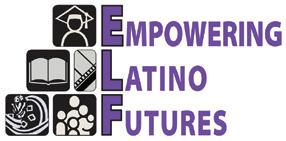

“El Mes de la Herencia Hispania es una manera de celebrar el presente, aprender del pasado y cultivar para el futuro. Nos educa respecto a la identidad—ser parte de algo, pertenecer. Nos recuerda que, cuando se quiere, se puede. Hubo grandes líderes antes de nosotros que cambiaron el mundo y, a pesar de los obstáculos actuales, está en nuestra sangre marcar la historia. “
–Jose Jaimes, director ejecutivo, Tierra Caliente Academy of Arts

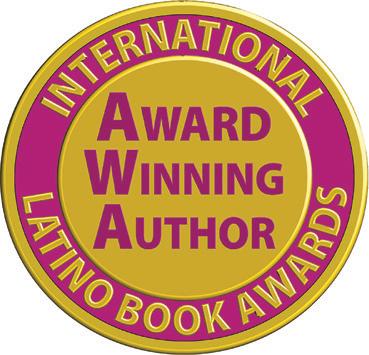
“Celebrar el mes de la Herencia Hispana es el reconocimiento del trabajo y sacrificios de nuestros ancestros, el impacto positivo de loa latinos en el presente y el avance juntos en el futuro. “
–Adriana Brunner, directora de desarrollo de negocios, MyPoint Credit Union
“Para mí, en realidad se trata del crecimiento. Uno de mis abuelos creció en un huerto de naranjas, recogiendo la fruta, y el otro trabajó en la construcción, con el acero. Mis padres estaban en mejores condiciones que mis abuelos, pero aun así vivían al día. Tenían muchas dificultades. Ahora, tengo libertad financiera y no vivo al día. Es sentirse agradecido por lo que ellos hicieron porque fueron sus sacrificios lo que me llevaron a este momento hoy. Y lo mismo hacia delante, con mis hijos por venir. Sé que el sacrificio de mis abuelos también llevó a eso. “
–Richard Huizar, ingeniero de prototipos en Apple
WWW.NORTHCOUNTYINFORMADOR.COM 11 SEPTEMBER 2023 Thank you for the work that you do to inspire others through the power of writing. International Latino Book Awards 2024 Recognizing greatness of books written by and about Latinos For information, go to www.latinobookawards.org Early Bird Deadline January 15
El Museo del Barrio en Carlsbad valora los artefactos familiares y culturales de los mexicanos que dejaron su país durante la Revolución. (Martha Zamora)
Art Season in Murals
The California Center for the Arts in Escondido offers an exciting season this year. To celebrate, the bridge on the walkway at the Center is covered in murals representing the shows and exhibitions to come.

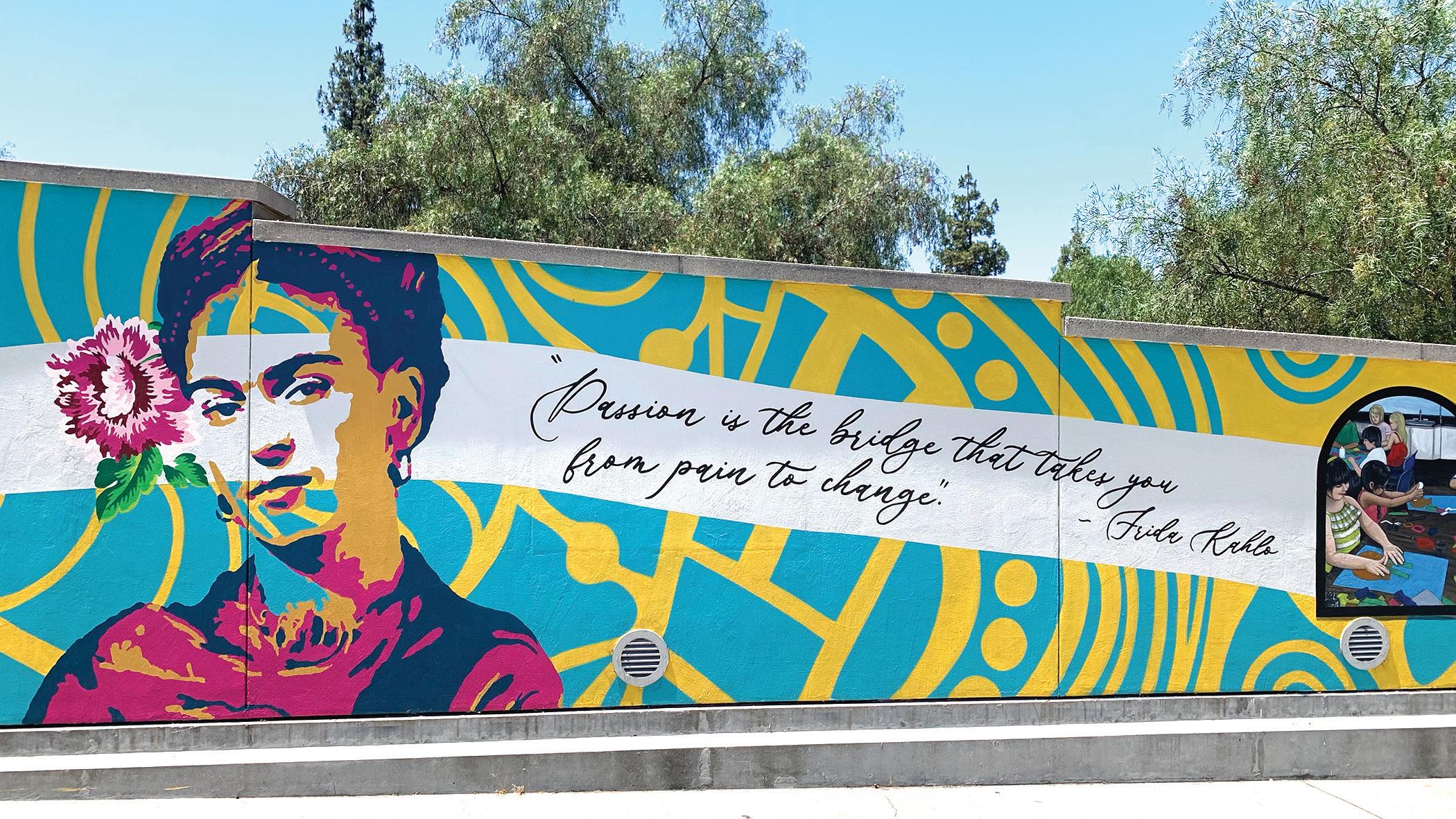
Enjoy the ‘Frida Kahlo: Through the Lens of Nickolas Muray’ exhibit through November 5. Also featured this season are the folklórico dancers and cultural plays from Tierra Caliente Academy.
Temporada artística en murales
El California Center for the Arts ofrece una temporada emocionante este año. Para celebrar, el puente en la pasarela se pinta de murales que representan las funciones y exposiciones por venir.
Disfruten esta temporada la exposición ‘Frida Kahlo: A través de la lente de Nikolas Murray’ hasta el 5 de noviembre. También este año se presentan los bailarines de la danza folklórica, así como obras de teatro culturales, con Tierra Caliente Academy.
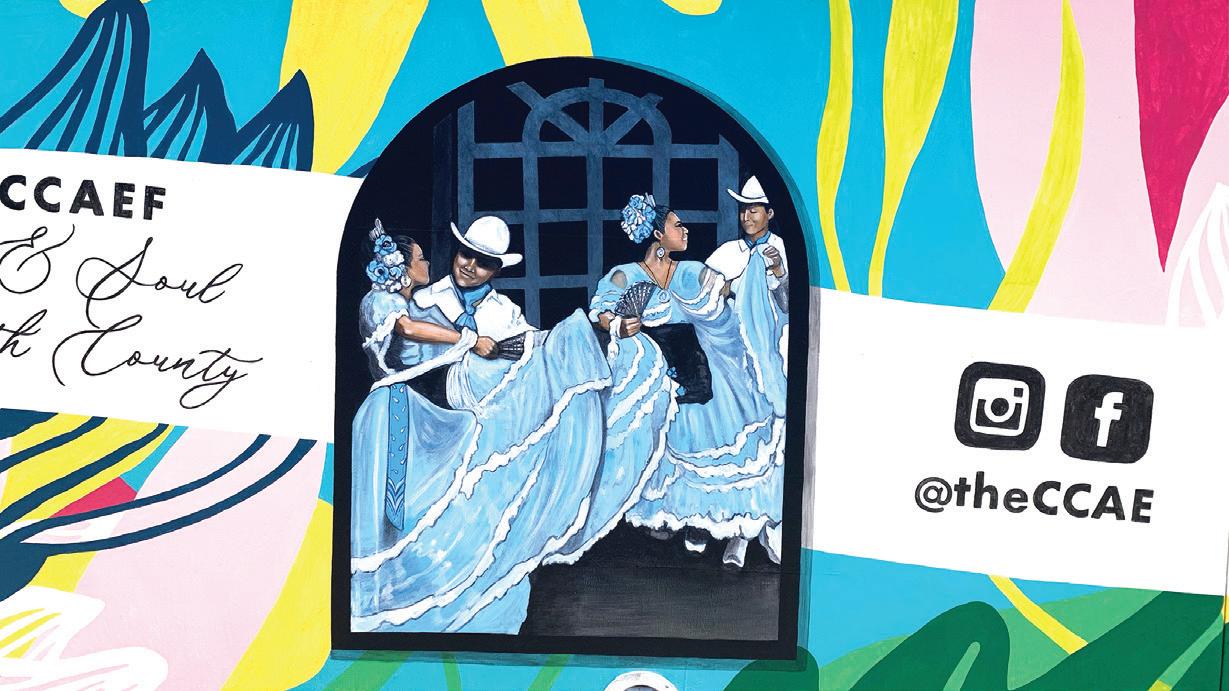
Fotos de José Jaimes, Tierra Caliente Academy
MÚSICA EN LA PLAZA
Lyric Courtyard 7:30–10:30 p.m.
- Free Community Event
- Evento Comunitario gratuito California Center for the Arts, Escondido www.artcenter.org
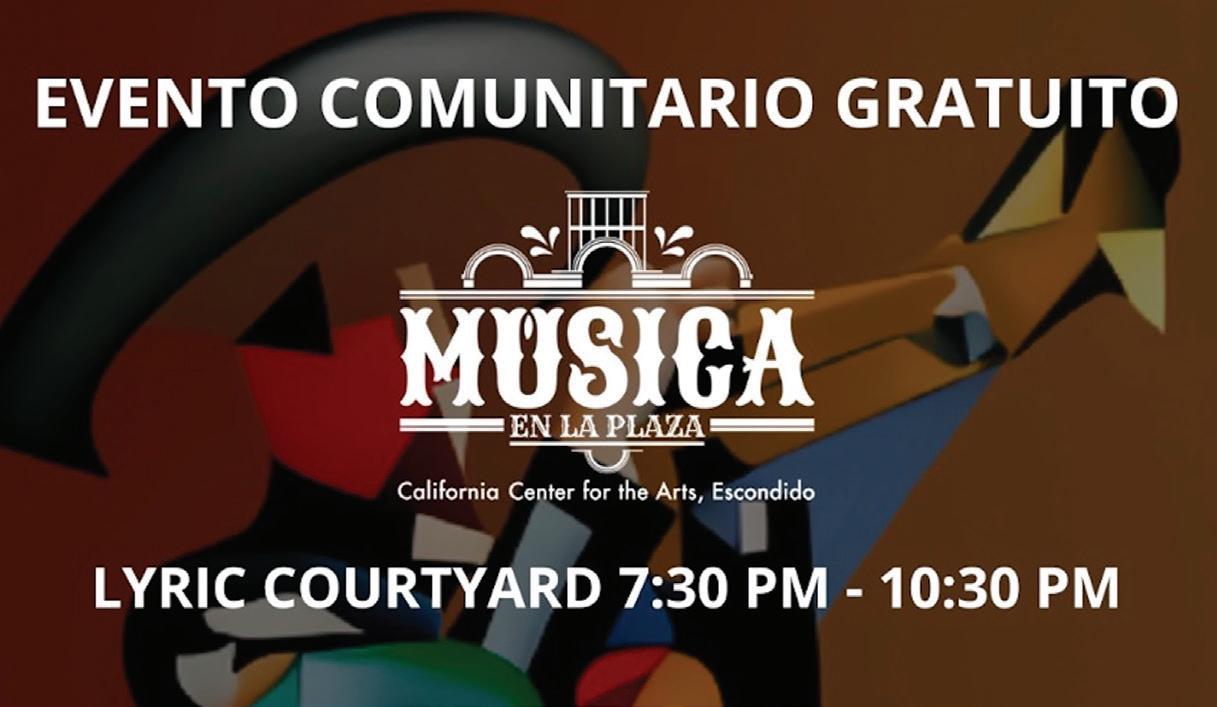
September 8: La Familia
September 15: Grupo Bella
September 22: Luisito Vadel
September 29: Coroneles del Señor
October 27: Azucar Band
September 10, 2 p.m.
De Colores Youth Dance Production
October 7, 7 p.m.
12 SEPTEMBER 2023 WWW.NORTHCOUNTYINFORMADOR.COM
EVENTS EVENTOS
Photos by José Jaimes, Tierra Caliente Academy

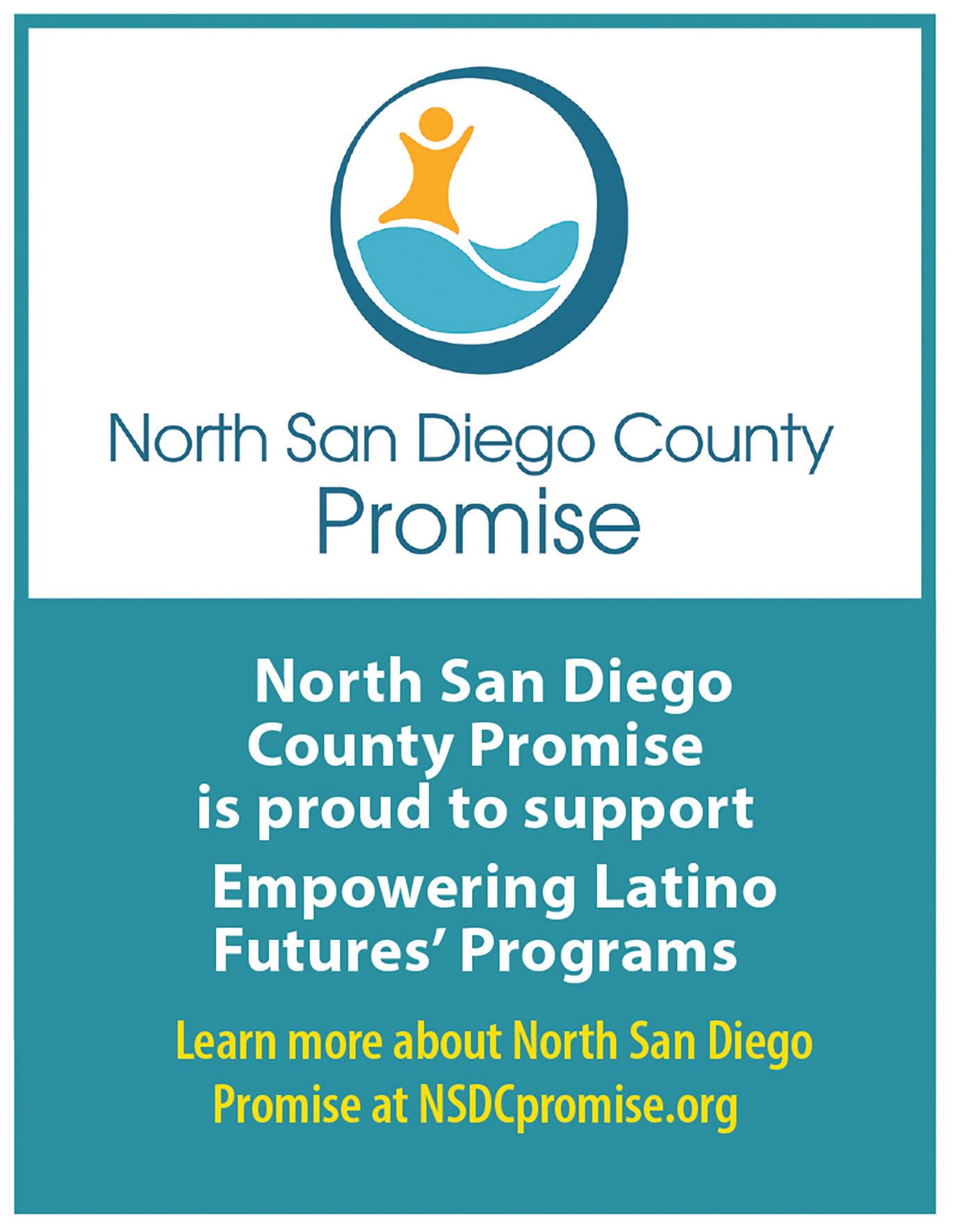

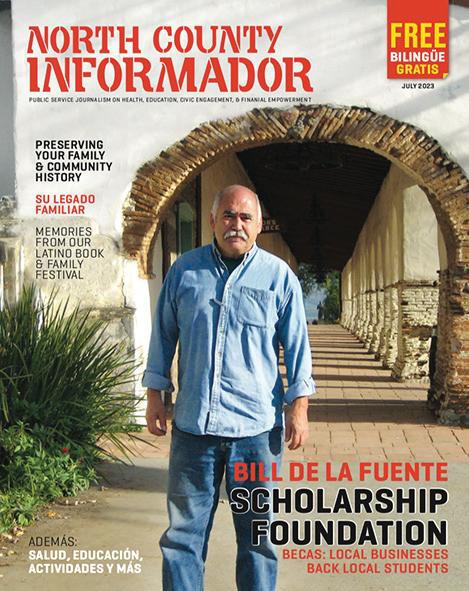
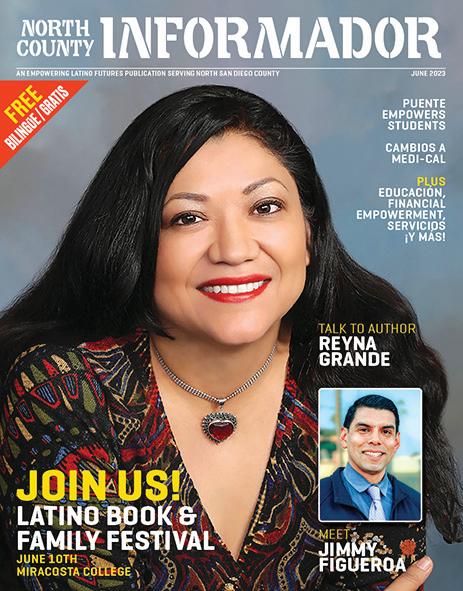



Richard Huizar: MIT Grad, Apple Engineer
LATINO STUDENT FROM SAN MARCOS DEFIES ROADBLOCKS TO SUCCESS
By Melanie Slone
Failing a class at MIT, not knowing how to get financial aid, being a first-generation college graduate…Richard Gabriel Huizar didn’t let any of it stop him.
Today, Richard works as a prototype mechanical engineer on the team behind the Apple Vision Pro. As a Latino who grew up in San Marcos, he is proud to have overcome the obstacles so many students face on their path to success.
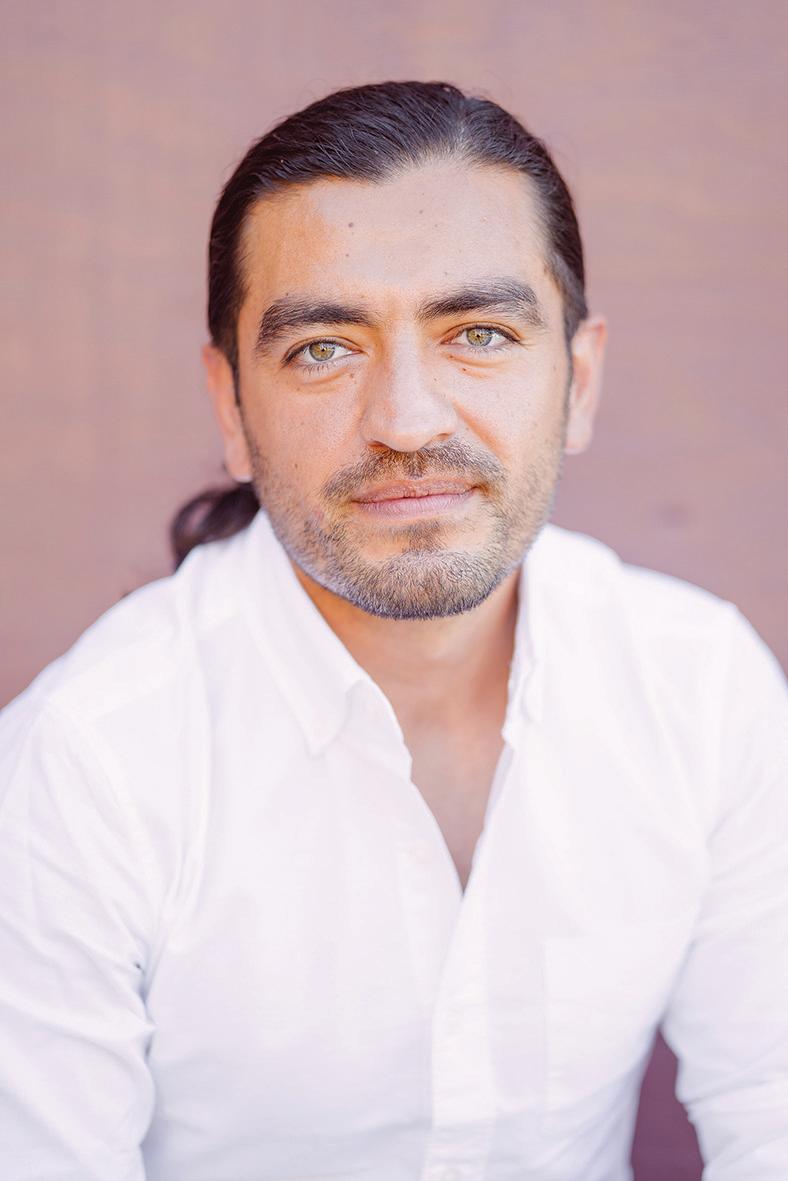
Knocking down barriers
Finances were the main hurdle, Richard told North County Informador. Planning to major in math at San Diego State, he realized he didn’t understand financial aid. He said his parents fell into the gap where they made too much to qualify him for assistance but not enough to help him pay for college.
“I didn’t know about applying for grants. I didn’t know about applying for scholarships and things like that,” he told us. So, San Diego State was no longer an option.
He said he wasn’t sure what he was going to do, but “I knew I needed to get an education.”
Some good advice came from his cousin, Lisa Montes, who was once School Relations/Diversity Outreach Specialist at MiraCosta College. Richard took a tour in 2012, “and just fell in love with the campus. MiraCosta in Oceanside is absolutely beautiful. The staff there
was extremely nice,” he said. He decided to enroll and worked a few jobs on campus while he completed his studies, immersing himself 100% in his education. One of his jobs was as a student ambassador, where he went to the high schools in North County to explain to kids that community college was an option for them.
“My main obstacle was definitely financial,” he told us, “And the second one, which is a pretty close second, is being uninformed, not having mentorship, not having the resources and the knowledge to know what to do to prepare for college.”
As an ambassador, he helped high schoolers overcome that barrier, telling them about the different options for college and the scholarship process.
“It was learning about these different application processes that I didn’t know when I was in high school,” he said.
Working with others also helped him get ready to transfer.
“Becoming a tutor at the math center on campus, one thing I quickly learned is the opportunities that a community college has,” he told us.
“What was reassuring to me is the mentorship I had at MiraCosta. They said, ‘We’ll make sure that your plan’s in place, that you are taking the correct classes. We’ll help you to search for the scholarships,
Richard remembered countless sleepless hours. He said he and his friends drove to San Diego State on the weekends to study because the library at MiraCosta wasn’t open on Sundays.
From MIT to Apple: Never Give Up
The hard work paid off. Richard was the first student from MiraCosta College to go to MIT.
14 SEPTEMBER 2023 WWW.NORTHCOUNTYINFORMADOR.COM FEATURE ARTÍCULO
MiraCosta and Palomar Colleges have guaranteed programs to transfer to UC and Cal State schools, but he decided to look at private schools as well because of their large endowments and scholarship funds.

After two years, he got his associate degree and was able to transfer.
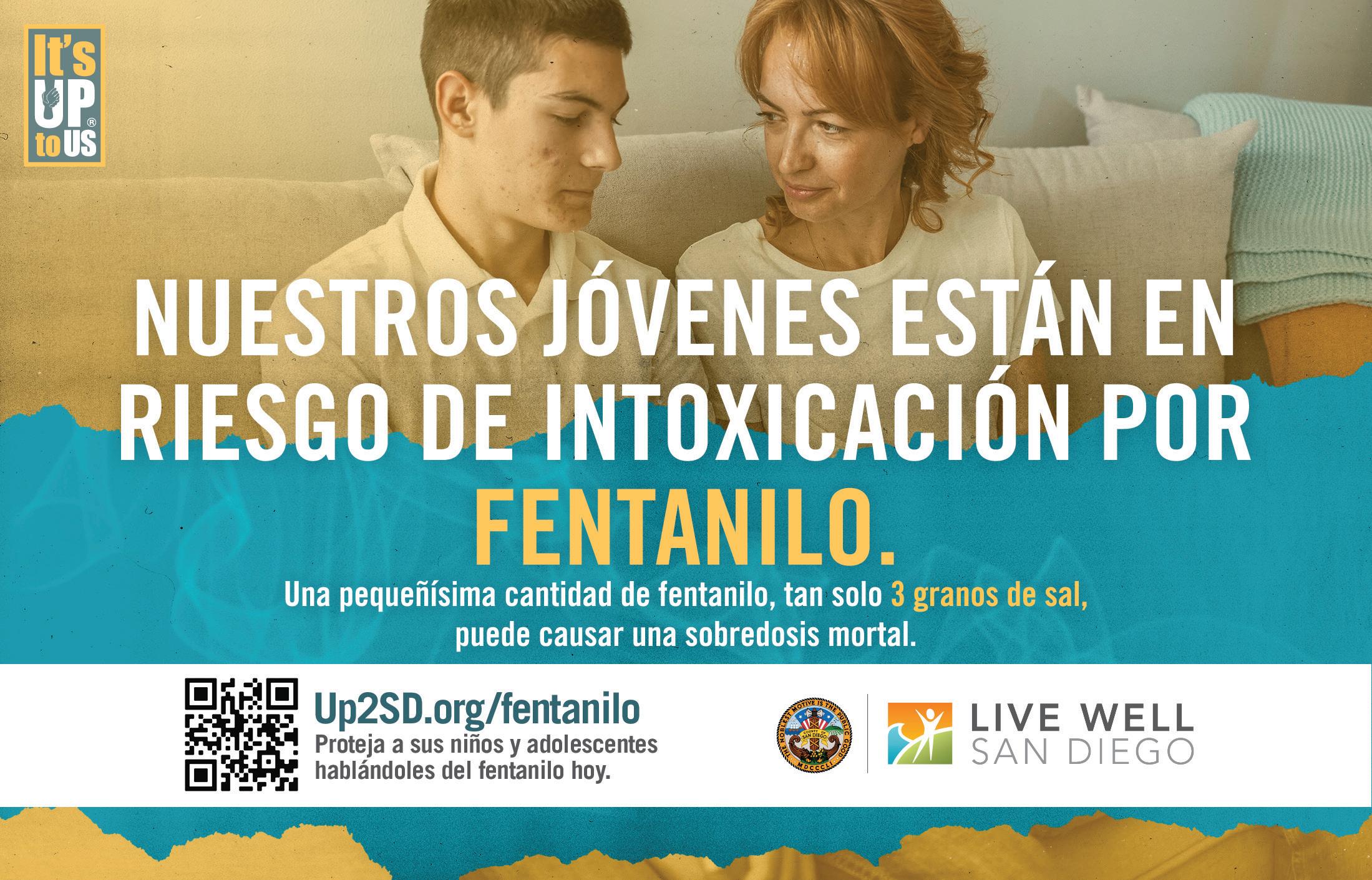
MIT called out to him because it was “not just the theoretical but also the practical end to the things that you’re learning,” he said. At that institution he was exposed to resources he couldn’t have had anywhere else, he noted.
MIT offers the opportunity to change majors at any point. He was a math major, but a friend encouraged him to try engineering, so he signed up for an Intro. to Mechanical Engineering class.
“The first test, I absolutely failed it,” he told us. “It just snowballed from there. It got worse and worse... second test, failed that one as well. So, I dropped that class.”
But he knew then that it was what he wanted to do with his life, apply mathematics to a practical function. Instead of giving up, he went to the professor who taught the class he had failed and asked him to be his advisor. “When I took it again the next semester, I aced it. From day one, I was ready to go… A lot more serious about it,” he remembered.
A VP from Apple was a professor at MIT, and Richard got an internship with the company his junior year. “I did an internship with input devices, so, working on various features of things like the mouse, Trackpad, pencil…”
As an intern, he realized he wanted a creative-type role in his work, a research-and-developmenttype role. “I love the creative side. I love thinking about how we can use technology in new ways and how we can do more things with it and get more features for people,” he said.
After this internship, he
graduated in 2018. But getting into Apple for good wasn’t easy. He went a few months without a job, spending time with his family and recentering himself. He moved to the San Francisco Bay Area and spent time concentrating reading every day, working out, and keeping a journal, building his life plan. After he had tried out a position with another
 Richard Huizar graduated from MiraCosta College and went to MIT.
Photo courtesy of Richard Huizar
Richard Huizar graduated from MiraCosta College and went to MIT.
Photo courtesy of Richard Huizar
company, in November 2018, his internship team from Apple reached out to him and offered him a position in R&D.
“We work at the intersection between technology and user experience,” he explained. “My team has worked on a first prototype of a phone with no home button... The Apple Pencil has a touch thing on it. That’s something our team did. And then we worked heavily on face ID.”
His latest team achievement is the Apple Vision Pro, “everything from the eye tracking that the Vision Pro does to other parts, other algorithms it has, and enabling all those,” he told us. He has also had a hand in iPhones, iPads, and many other Apple products.
Family First
Despite all his success at school and with Apple, Richard always puts his family first.
“My family were the rock of my support,” he told us. “They were always there to support me, to say, you can do it, to cheer me on, to do what they can to help, whether that’s letting me stay at home either rent-free or with cheap rent, giving me time here and there to figure things out… That love and compassion speaks volumes. It’s one of the foundations that helped me through it.”
Even with the constant family support, Richard acknowledged that it can be difficult, especially for Latinos.

“I didn’t really have anyone in my family that I looked up to in terms of education,” he told us. “There’s always been that disconnect because they’d never gone through it. Yes, they support me, they love me, but they don’t understand what this all entails.”
His parents instilled the need for an education, he told us, but they didn’t know how to get there.
“I didn’t realize how important the associate degree and just going through that first step were,” he added. He was the first member
of his family to walk at a college ceremony, at MiraCosta College. Then, he said, “five or six of my cousins…went back to school to get their bachelor’s and went back to that same system that I went through. And they’re six, seven years older than I am.” He said his encouragement was their guide. “Seeing my family go back to school because of the work that I did was a huge win for me,” he said.
And, he said, family still comes first. During the pandemic, his grandfather was sick, so he asked Apple in San Jose if he could work from San Diego during social distancing and spend time with him.
“In 2020, I actually moved home to San Diego, unofficially working from San Diego, back and forth, and spent three days a week after work with my grandpa during Covid,” he said. “For a good six to eight months, I was able to be at home and spend that time with my family.”
In July 2021, he was officially relocated to San Diego, and now he is close to his family. “That was very different from college where it’s 100% work, or the first two years, to 100% realizing that family is a lot more important,” he said.
Tips for students and families

Richard told us what kids and parents can do to prepare for college and a career like his. His big tip is, start early. “It’s that mindset from the very beginning,” he said. “Start from elementary school to get prepared for college.”
Thinking of the next generation in his own family, “One thing I ask my little cousins, they could be six years old, they could be 10 years old, but I ask them, what college are you going to?” he said. “I don’t ask them that in high school. I ask them in elementary school to get the mindset of, you’re really going to go there.”
Richard believes it is important to know what classes you need to take in high school before you even start.
help. “I think there’s a lot of things I missed because I thought I was fine,” he explained. He suggested asking what classes are good to take for college.
“Everyone there is to help you, but they’re not going to give their full interest until you ask,” he said. “So, if you’re reaching out to them, they’ll connect you to who is best for you. And then, once you get connected with that one or two key people, that’s a game changer,” he said.
“You have someone on your side that is going to show you that roadmap one step at a time and tell you to aim higher than you thought you could.”
Besides family support, he believes mentoring was key to his success. “I think that was a big difference for me from high school days to community college days,” he told us.
Read about the Apple Vision Pro Richard worked on: https://www.apple.com/applevision-pro/
16 SEPTEMBER 2023 WWW.NORTHCOUNTYINFORMADOR.COM
Photo: Gabriel Liendo
Richard Huizar: Graduado de MIT, ingeniero en Apple

ESTUDIANTE LATINO DE SAN MARCOS SUPERA OBSTÁCULOS PARA LOGRAR EL ÉXITO
Por Melanie Slone
Reprobar una materia en MIT, no saber cómo conseguir asistencia financiera y ser un graduado universitario de primera generación… Richard Gabriel Huizar no se detuvo ante nada.
Hoy, Richard trabaja como ingeniero mecánico de prototipos en el equipo que diseñó el Apple Vision Pro. Como un latino que creció en San Marcos, se siente orgulloso de haber superado los obstáculos que tantos estudiantes enfrentan en su camino hacia el éxito.
Rebasar barreras
Las finanzas representaban el principal obstáculo, Richard contó a North County Informador. Aunque pensaba estudiar matemáticas en San Diego State, se dio cuenta de que no contaba con los fondos. Dijo que sus padres estaban en ese grupo que ganaba demasiado como para que él recibiera ayuda financiera, pero no ganaban lo suficiente para ayudarlo a pagar la universidad.
“No sabía nada de solicitar grants. No sabía pedir becas y esas cosas”, nos dijo. Así que San Diego State ya no era opción. Dijo que no estaba seguro qué iba a hacer, pero “sabía que debía tener estudios”.
Recibió un buen consejo de su prima, Lisa Montes, quien una vez fue directora de relaciones escolares y difusión en comunidades diversas en MiraCosta College. Richard hizo una gira en 2012, “y simplemente me enamoré del plantel. MiraCosta en Oceanside es realmente hermoso. El personal es excepcionalmente amable”, dijo.
Decidió inscribirse y tuvo unos empleos en el plantel mientras estudiaba, para así sumergirse al 100 % en su educación. Uno de sus trabajos fue como alumno embajador, por lo que iba a las high schools en el norte del condado para explicar a los jóvenes que el community college era una opción.
“Mi principal obstáculo sin duda fue financiero”, nos dijo, “seguido muy de cerca por el hecho de no tener información, no tener un mentor, no contar con los recursos ni el conocimiento para saber cómo prepararme para la universidad”.
Como embajador, él ayudaba a estudiantes en las high schools a superar las barreras al contarles sobre las opciones para ir a la universidad y el proceso de becas.
“Estaba aprendiendo sobre estos diferentes procesos de solicitud que no conocía cuando yo iba a la high school”, dijo.
Al trabajar con otros, también se preparó para su propia transferencia. “Al convertirme en tutor en el centro de matemáticas en el plantel, aprendí rápido sobre las oportunidades que tiene un community college”, nos dijo.
“Lo que me reconfortaba era la asesoría que tenía en MiraCosta. Dijeron, ‘Vamos a asegurarnos de que tengas un plan, de que tomes las materias adecuadas. Te ayudaremos a buscar las becas, pero tú tienes que trabajar duro en la escuela’”.
Richard recordó horas innumerables sin dormir. Dijo que manejaba con sus amigos a San Diego State a estudiar los fines de semana ya que la biblioteca de MiraCosta no abría los domingos.
De MIT a Apple: Nunca rendirse
Richard fue el primer estudiante de MiraCosta College en transferir a MIT.
MiraCosta y Palomar College tienen programas que garantizan la transferencia a las universidades UC y las estatales, pero él decidió considerar además las escuelas privadas por sus fondos grandes de dotación y para becas.
Después de dos años, recibió su grado de asociado y pudo transferirse.
MIT lo atraía porque era “no solo era el uso teórico sino también práctico de todo lo que uno aprende”, dijo. Notó que, en esa universidad, tuvo acceso a recursos que no habría tenido en ningún otro lado.
MIT ofrece la oportunidad de cambiar de carrera en cualquier momento. Él estudiaba matemáticas, pero un amigo lo alentó a probar la ingeniería, así que se inscribió en una clase de Introducción a la Ingeniería Mecánica.
“El primer examen, lo reprobé por completo”, nos dijo. “Y de ahí se agravó todo, cada vez peor…el segundo examen, también lo reprobé. Así que me di de baja de ese curso”.
Pero sabía entonces lo que quería hacer en su vida, aplicar la matemática a una función práctica. En vez de darse por vencido, platicó con el profesor que impartía la materia que había reprobado y le pidió ser su asesor. “Cuando llevé la materia de nuevo el siguiente semestre, pasé fácil. Desde el primer día, estaba listo…mucho más serio”, recordó.
Una vicepresidenta de Apple era profesora en MIT y Richard consiguió una pasantía con la empresa en su tercer año. “Hice una pasantía con dispositivos
WWW.NORTHCOUNTYINFORMADOR.COM 17 SEPTEMBER 2023 FEATURE ARTÍCULO
de entrada, entonces trabajé en funciones de cosas como el mouse, Trackpad, Pencil…”
Como pasante, se dio cuenta de que quería trabajar en algo creativo, algo relacionado con investigación y desarrollo. “Amo la parte creativa. Amo pensar en cómo podemos usar la tecnología de formas nuevas y cómo podemos hacer más con ella y ofrecer más funciones a la gente”, dijo.
Después de esta pasantía, se graduó en 2018. Pero entrar de planta a Apple no fue fácil. Pasó unos meses sin empleo, con su familia, y volvió a enfocarse.
Se fue a vivir al Área de la Bahía de San Francisco sin trabajo y se concentró en leer todos los días, hacer ejercicio y escribir en su diario, para construir su plan de vida. Después de probar una posición con otra empresa, en noviembre de 2018, recibió una llamada de su equipo de pasantía en Apple, quienes le ofrecieron un puesto en investigación y desarrollo.
“Trabajamos en el cruce entre la tecnología y la experiencia del usuario”, explicó. “Mi equipo desarrolló un primer prototipo del iPhone sin botón de inicio…El Lápiz de Apple tiene una cosita de contacto. Es algo que nuestro equipo hizo. Y trabajamos de lleno en la identificación facial”.
El último logro de su equipo es el Apple Vision Pro, “todo, desde el rastreador ocular que hace el Vision Pro hasta otros componentes, otros algoritmos que tiene, y hacer que estos funcionen”, nos contó. También ha trabajado un poco en iPhones, iPads y muchos otros productos de Apple.
Primero la familia
Independientemente de su éxito en la escuela y con Apple, Richard siempre coloca a su familia en primera fila.
“Mi familia era la roca de mi apoyo”, nos dijo. “Siempre estaban ahí para apoyarme, para decir sí se puede, alentarme, hacer lo que pudieran para ayudar, dejarme vivir en casa ya sea sin pagar renta o pagar una cantidad mínima, darme tiempo
a veces para pensar las cosas… Ese amor y esa compasión dice tanto. Es uno de los cimientos que me ayudó a sobrellevar todo”.
Aun con el apoyo de la familia, Richard reconoció que puede ser difícil, sobre todo para los latinos.
“En realidad no tenía a nadie en mi familia a quien admirar en lo educativo”, nos dijo. “Siempre ha existido esa desconexión porque ellos no lo habían vivido. Sí, me apoyan, me aman, pero no entienden todo lo que esto implica”.
Sus padres le inculcaron la necesidad de tener una educación formal, nos dijo, pero no sabían cómo conseguirla.
“No me daba cuenta de lo importante del grado de asociado y simplemente tomar ese primer paso”, agregó. Él es el primer miembro de su familia que participó en una ceremonia de graduación, la cual fue en MiraCosta College. Entonces, dijo, “cinco o seis de mis primos… volvieron a la escuela a hacer su licenciatura y regresaron a ese sistema por el cual yo pasé. Y me llevan unos seis, siete años”. Dijo que su impulso fue su guía. “Ver a mi familia regresar a la escuela gracias al trabajo que yo hice fue una gran victoria para mí”, dijo.

Subrayó que la familia sigue estando en primer lugar. Durante la pandemia, su abuelo se enfermó, así que Richard pidió a los de Apple en San José que lo dejaran trabajar desde San Diego durante las políticas de distanciamiento social para que él pudiera pasar tiempo con su abuelo.
“En 2020, hasta me cambié a San Diego, de manera no oficial trabajaba desde San Diego, iba y venía, y pasaba tres días a la semana después del trabajo con mi abuelo durante Covid”, dijo. “Durante unos seis a ocho meses, pude estar en casa y pasar ese tiempo con mi familia”.
En julio de 2021, se le mandó de manera oficial a San Diego, y ahora Richard está cerca de su familia.
“Fue muy diferente a los días de universidad, donde es 100 % trabajo, o los primeros dos años como
empleado, a ahora darse cuenta al 100 % de que la familia es mucho más importante”, dijo.
Consejos para estudiantes y familias
Richard nos compartió lo que los jóvenes y los padres de familia pueden hacer para prepararse para la universidad y una carrera como la suya. Su consejo principal es, empiecen desde temprano. “Es tener esa mentalidad desde el comienzo”, dijo. “Empezar desde la primaria a prepararse para la universidad”.
Está pensando en la próxima generación en su propia familia.
“Algo que pregunto a mis primos pequeños, tengan seis o tengan 10 años, les pregunto, ¿a qué universidad van a ir?”, dijo. “No les hago esta pregunta en la high school. Les hago esta pregunta en la primaria, para que desarrollen la mentalidad de, de veras van a ir”.
Richard cree que es importante saber qué materias hay que tomar en high school antes de inscribirse.
También recomendó pedir ayuda. “Creo que hay muchas cosas que me perdí porque pensaba que iba bien”, explicó. Sugirió preguntar qué clases tomar para llegar a la universidad.
“Todo mundo está para ayudarte, pero no te van a dar todo su interés hasta que preguntes”, dijo. “Entonces, si los buscas, ellos van a conectarte con quienes mejor te puedan ayudar. Y luego, una vez que te hayas conectado con esa persona o esas dos personas clave, eso lo cambia todo”, dijo.
“Tienes a alguien de tu lado que te va a enseñar el camino un paso a la vez y alentarte a apuntar más alto de lo que creías posible”.
Además del apoyo de la familia, él cree que la asesoría fue clave en su éxito. “Creo que fue una gran diferencia para mí entre lo que viví en la high school y lo que viví en el community college”, finalizó.
Para leer sobre el Apple Vision Pro en el que Richard trabajó: https:// www.apple.com/apple-vision-pro/
18 SEPTEMBER 2023 WWW.NORTHCOUNTYINFORMADOR.COM
CIVIC ENGAGEMENT CIVISMO
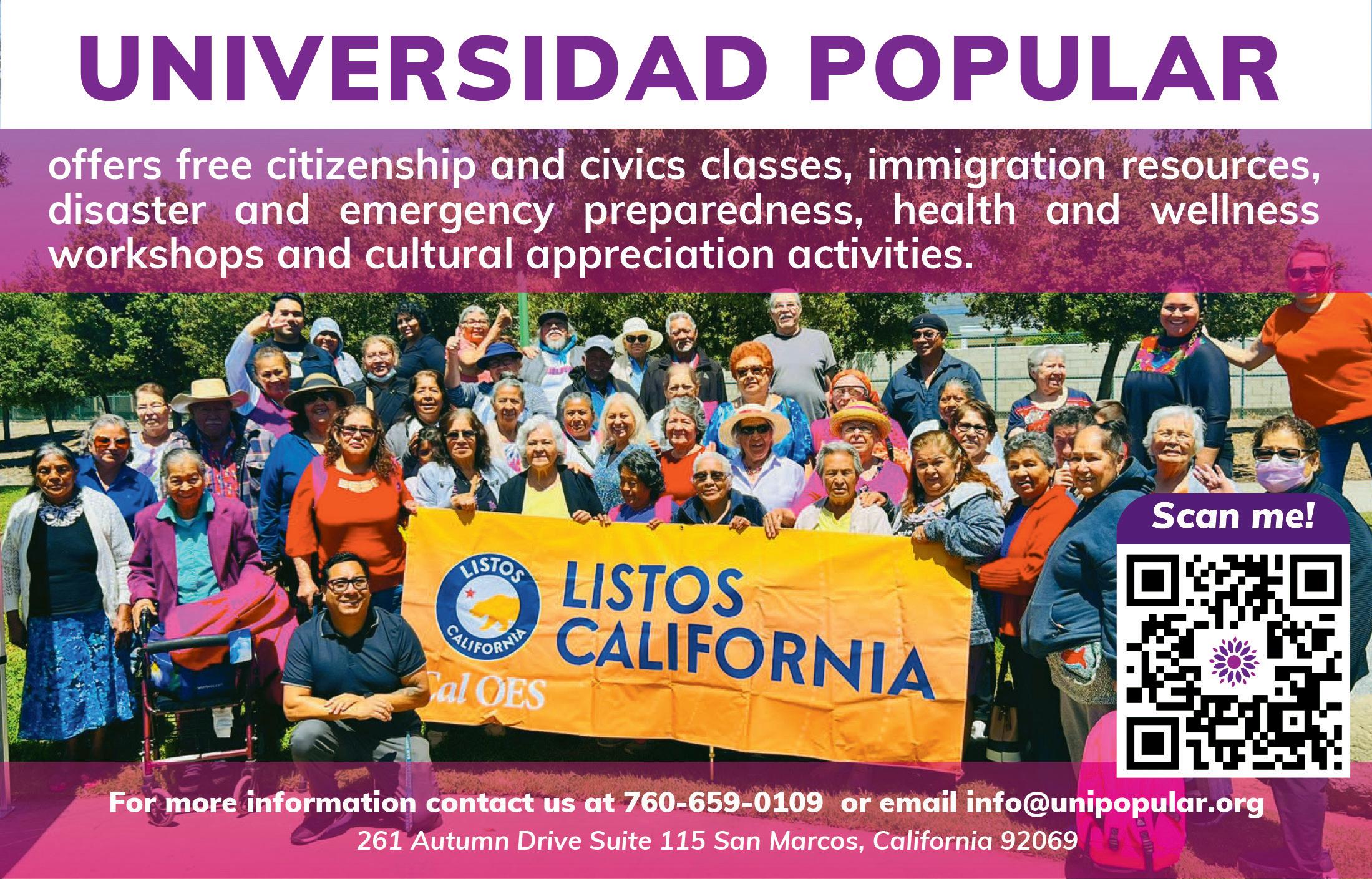
What Are the Primaries?
How do Presidential Primary Elections work?
For presidential primary elections, you can only vote for your party’s presidential candidates in a primary election. Whoever wins the most votes in the California primary is the winning candidate from that party for the state. Each state chooses a presidential candidate in this way. Whoever wins the most states will be the presidential candidate for that party.
Some parties allow voters registered with No Party Preference to vote for their presidential candidates at a primary election. No Party Preference voters must request a “cross-over” ballots either from their county elections official or at the polls.
How do statewide primary and general elections work?
A primary election determines which candidates advance to a general election.
Any voter may vote for any one candidate in each contest, regardless of the voter’s or candidate’s political party. The toptwo candidates, who receive the most votes in each primary contest move on to the general election.
¿Qué son las elecciones primarias?
¿Cómo funcionan las elecciones primarias presidenciales? Para las elecciones primarias presidenciales, usted solo puede votar por un candidato del partido político al cual usted está suscrito. El que gane más votos en la elección primaria en California será el candidato. Así, cada estado elige a un candidato presidencial. El o la que tenga más estados ganados será candidato/a a la presidencia para ese partido.
Algunos partidos políticos permiten que los votantes sin preferencia de partido voten por sus candidatos en las elecciones primarias. Los votantes sin preferencia de partido deben solicitar una boleta electoral “cruzada”, ya sea al funcionario electoral de su condado o en el lugar de votación.
¿Cómo funcionan las elecciones primarias estatales?
Una elección primaria determina qué candidatos son nominados para pasar a las elecciones generales.
Cualquier votante puede votar por un candidato en cada contienda electoral, independientemente del partido político del votante o del candidato. Los dos candidatos principales, que reciben la mayor cantidad de votos en cada contienda primaria pasan a las elecciones generales.
TrueCare and UC Health Milk Bank Partner to Help Mothers and Save Babies’ Lives
Interview by Martha Zamora
On August 12, TrueCare held an event with UC Health Milk Bank to teach women about the importance of breastfeeding, give out supplies, and collect breast milk for babies in the NICU.
Challenges for new moms compound when the mother has health issues that keep her from breastfeeding her newborn. UC Health Milk Bank is there to help.
“We screen donors who have extra milk and want to donate it,” said Mayra Rivera, a bilingual coordinator with the program.
Mothers are asked to fill out a questionnaire about their health and to answer some questions. A blood test is also performed.
“It’s always safer to do donations through a milk bank just to make sure there’s no risk of transmittable diseases or medications that are not safe for babies,” Mayra said.
Mayra hopes Latina moms will learn about the program and how it can save babies’ lives. “I know Latinas are always willing to help,” she said.
The components in breast milk help babies develop a better immune system, leading to lower rates of obesity, diabetes, and cardiovascular disease, and a higher IQ. Donated milk is also better than formula because it protects against bowel problems that can affect newborns.
UC Health Milk Bank is on Facebook and Instagram. Mayra Rivera can answer your questions in English and Spanish. Also, visit https://hmi.ucsd.edu/programs/milk-bank.html
Protect your Medi-Cal Coverage
By Selen Ozturk, Ethnic Media Services
Between June 2023 and May 2024, 15.5 million Medi-Cal enrollees—one-third of all Californians—will have their eligibility redetermined.
Yingjia Huang, deputy director of Health Care Benefits and Eligibility for the California Department of Health Care Services (DHCS), said in June, the first month of disenrollment, 21%—or 225,231 people—from the over one million Californians up for renewal were dropped from Medi-Cal. Over half identified as Hispanic, 16% as white, 6% as Black and 2% AAPI.
Nearly 87% of those disenrolled were dropped for procedural reasons, such as “because the member did not return the renewal packet,” said Huang.
People disenrolled procedurally have 90 days from June, through September 30, to return their packets to get reinstated. Contact TrueCare for help. https://truecare.org/ 760-736-6767
El 12 de agosto, TrueCare llevó a cabo un evento con UC Health Milk Bank para enseñar a las mujeres sobre la importancia de la lactancia, regalar cosas y recolectar lecha materna para bebés en cuidados intensivos.
Los retos para las madres aumentan cuando la madre sufre de problemas de salud que no le permiten dar pecho a su recién nacido. UC Health Milk Bank llega para ayudarlas.
“Hacemos una revisión a las donadoras que tienen leche de más y quieran donarla”, dijo Mayra Rivera, una coordinadora bilingüe con este programa. A las madres se les pide llenar un cuestionario sobre su salud y contestar algunas preguntas. También se les realiza una prueba de sangre.
“Siempre es más sano donar mediante un banco de leche para asegurarnos de que no exista riesgo de enfermedades transmisibles o medicamentos peligrosos para los bebés”, dijo Mayra.
Mayra espera que las madres latinas aprendan sobre el programa y cómo puede salvar la vida de críos recién nacidos. “Sé que las latinas siempre están dispuestas a ayudar”, dijo.
Los componentes en la leche materna ayudan a los bebés a desarrollar un mejor sistema inmunológico. La lecha donada también es mejor que la fórmula porque protege contra los problemas intestinales que pueden afectar a los recién nacidos.
Encuentren UC Health Milk Bank en Facebook e Instagram. Mayra Rivera puede ayudarles en inglés y español. O visiten https://hmi. ucsd.edu/programs/milk-bank.html
Protejan su Medi-Cal
Por Selen Ozturk, Ethnic Media Services
Entre junio de 2023 y mayo de 2024, se volverá a determinar la elegibilidad de 15.5 millones de personas inscritas en Medi-Cal, un tercio de todos los californianos.
Yingjia Huang, subdirectora de Beneficios y Elegibilidad de Atención Médica del Departamento de Servicios de Atención Médica (DHCS) de California, dijo que, en junio, el 21%, o 225,231 personas de los más de un millón de californianos que solicitaron la renovación, fueron dadas de baja de Medi-Cal. Más de la mitad se identificaron como hispanos, el 16 % como blancos, el 6 % como negros y el 2 %, AAPI.
Casi el 87% de las personas desafiliadas fueron canceladas por razones de procedimiento, como “porque el miembro no devolvió el paquete de renovación”, dijo Huang.
Las personas desafiliadas procesalmente tienen 90 días desde junio hasta el 30 de septiembre para devolver sus paquetes para ser reincorporados. Contacten TrueCare para ayuda: https://truecare.org/ 760-736-6767
20 SEPTEMBER 2023 WWW.NORTHCOUNTYINFORMADOR.COM HEALTH SALUD
TrueCare y UC Health Milk Bank se unen para ayudar a madres y salvar la vida de recién nacidos
Entrevista de Martha Zamora
FINANCIAL FINANZAS
Financial Education in 4 Easy Steps
By Adriana Brunner
Many of the decisions we make every day depend on our knowledge of finances. But it can be a very intimidating topic. Talking about budgets, credit, or investments can be a little overwhelming.
We don’t have to be experts in everything, but we do have to have allies we can learn from. Credit unions are great options because they are the community financial educators, guiding people through the steps toward financial success.
Some great tools like GreenPath and Zogo (apps) offer assistance in Spanish, such as a budget spreadsheet, tips to improve our credit score, and ideas about how to purchase a car or home.
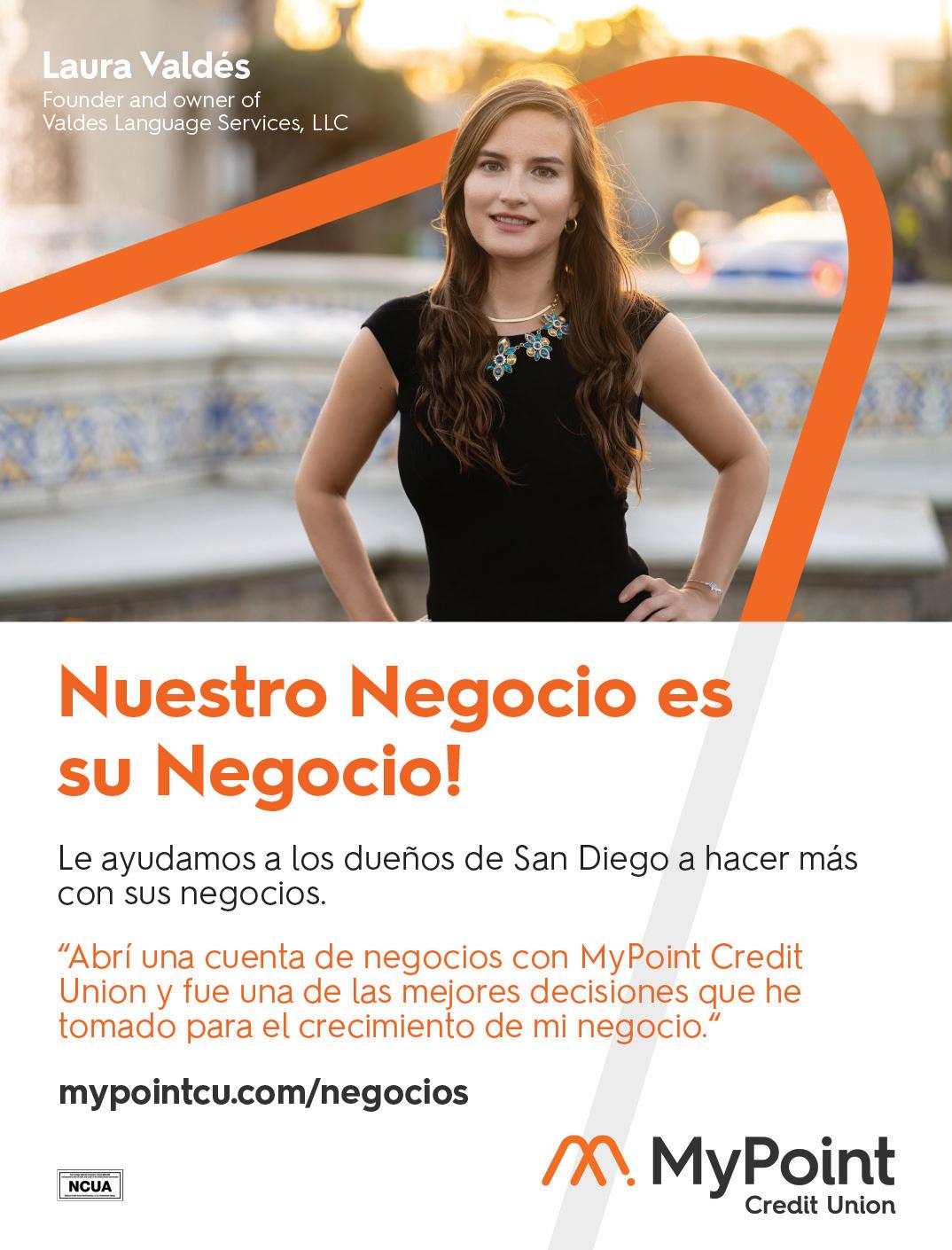
Here are four financial tips for you:
4 pasos hacia la educación financiera
Por Adriana Brunner
Es muy importante que nuestra comunidad entienda que muchas de las decisiones que tomamos día a día dependen de nuestros conocimientos financieros. En realidad, es un tema que intimida bastante. Hablar de presupuestos, crédito o inversiones puede generar temor.
No tenemos que ser expertos en todo, pero sí tener aliados de los que podamos aprender. Las cooperativas de crédito son un gran ejemplo, pues son los educadores financieros de la comunidad y guían sobre los pasos a seguir para alcanzar el éxito financiero.
Herramientas increíbles como GreenPath y Zogo (aplicaciones) ofrecen ayuda en español, como una hoja de presupuesto, consejos para mejorar el crédito e ideas de cómo comprar un carro o una casa.
Me gustaría darles cuatro consejos:
Es muy importante tener un presupuesto. Esto les va a ayudar a controlar sus gastos y a ahorrar. En este enlace pueden encontrar algunos ejemplos de cómo hacer un presupuesto:
https://www.greenpath.com/wellness/espanol
No es malo tener crédito, pues se necesita para comprar casa o carro y hasta para arrendar una propiedad. El secreto es saber cómo manejarlo. ¿Sabían que pueden construir crédito con una tarjeta de crédito garantizada (disponible en las cooperativas de crédito)?
Es crítico tener un fondo de emergencia. Es muy recomendable contribuir con un 10 % de sus ingresos mensuales.


Pueden ahorrar por medio de un certificado de depósito a término (CD). En muchas cooperativas, empiezan con una contribución de solo $100.
Para finalizar, quiero dejarles este recurso valioso para educarse más en el aspecto financiero: www.mypointcu.com/learn/
Adriana Brunner
Director of Business Development
Credit Union
It is very important to have a budget, which will help you control your spending and save money. This link gives some examples of how to write a budget: https://www.greenpath. com/wellness/espanol
Having credit is not a bad thing; it is necessary if you want to buy a home or car or even to rent property. The secret lies in how you manage your credit. Did you know you can build credit with a secured or guaranteed credit card (available at credit unions)?
It is essential to have an emergency fund. We recommend putting 10% of your monthly income into this fund.
You can save more with a Certificate of Deposit (CD). Many credit unions allow you to open one with as little as $100.
Finally, I would like to leave you with this valuable resource that will help you learn more about finances: www.mypointcu.com/learn/resources
WWW.NORTHCOUNTYINFORMADOR.COM 21 SEPTEMBER 2023
MyPoint
abrunner@mypointcu.com (858)
Your
243-7471
SERVICES SERVICIOS Free Food Distribution
with True Care & Feeding San Diego
San Marcos
1st and 3rd Wednesday of every month, 11 a.m. to 12:30 p.m.
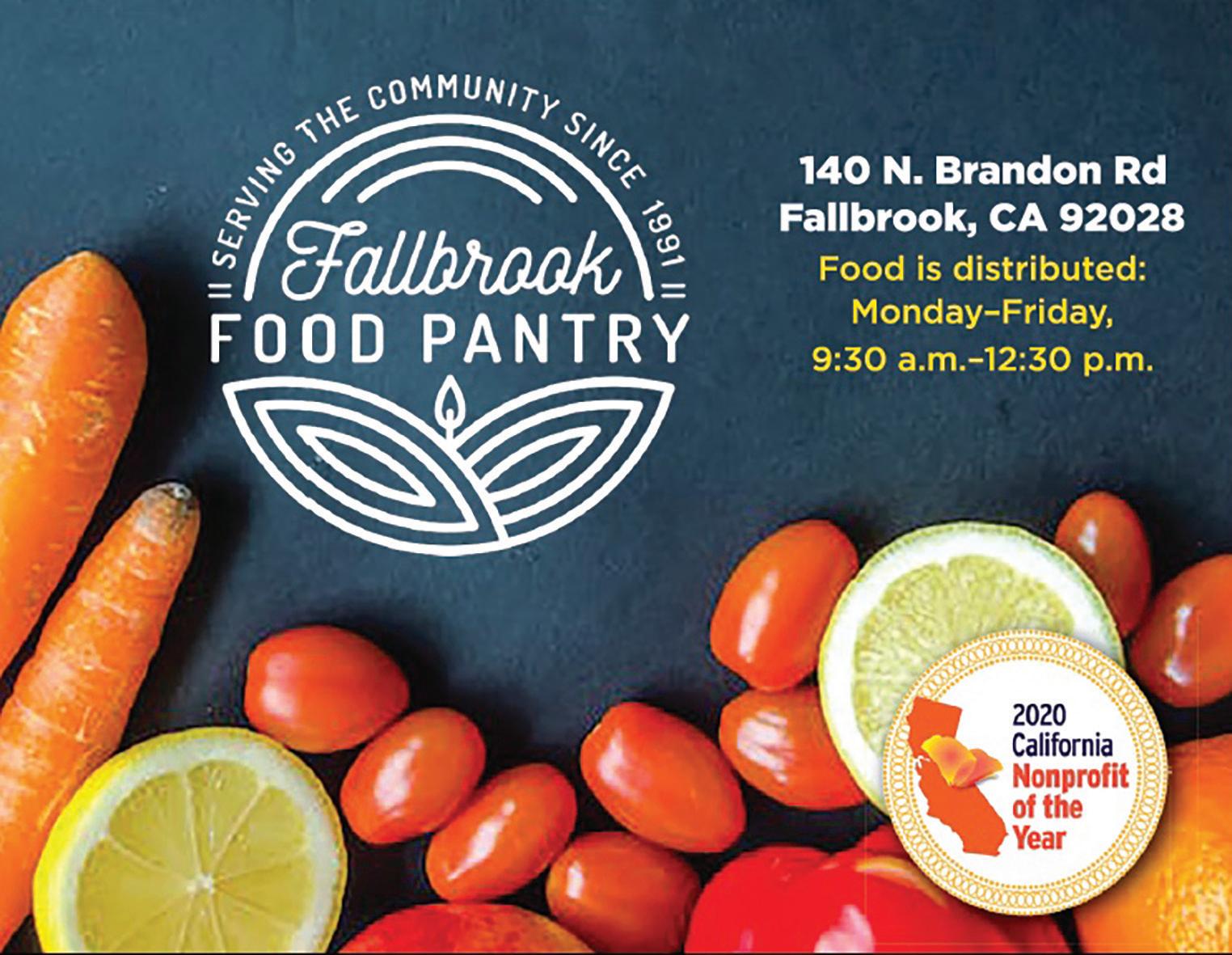
ONE SAFE PLACE
1050 Los Vallecitos Boulevard
San Marcos CA 92069
(760) 290-3690
- Therapy / Terapia
- Children’s Area / Zona para menores
- Restraining Orders / Interdictos de restricción
- Safe Housing Assistance / Ayuda con vivienda segura
- Child Advocacy Center / Centro de abogacía para menores
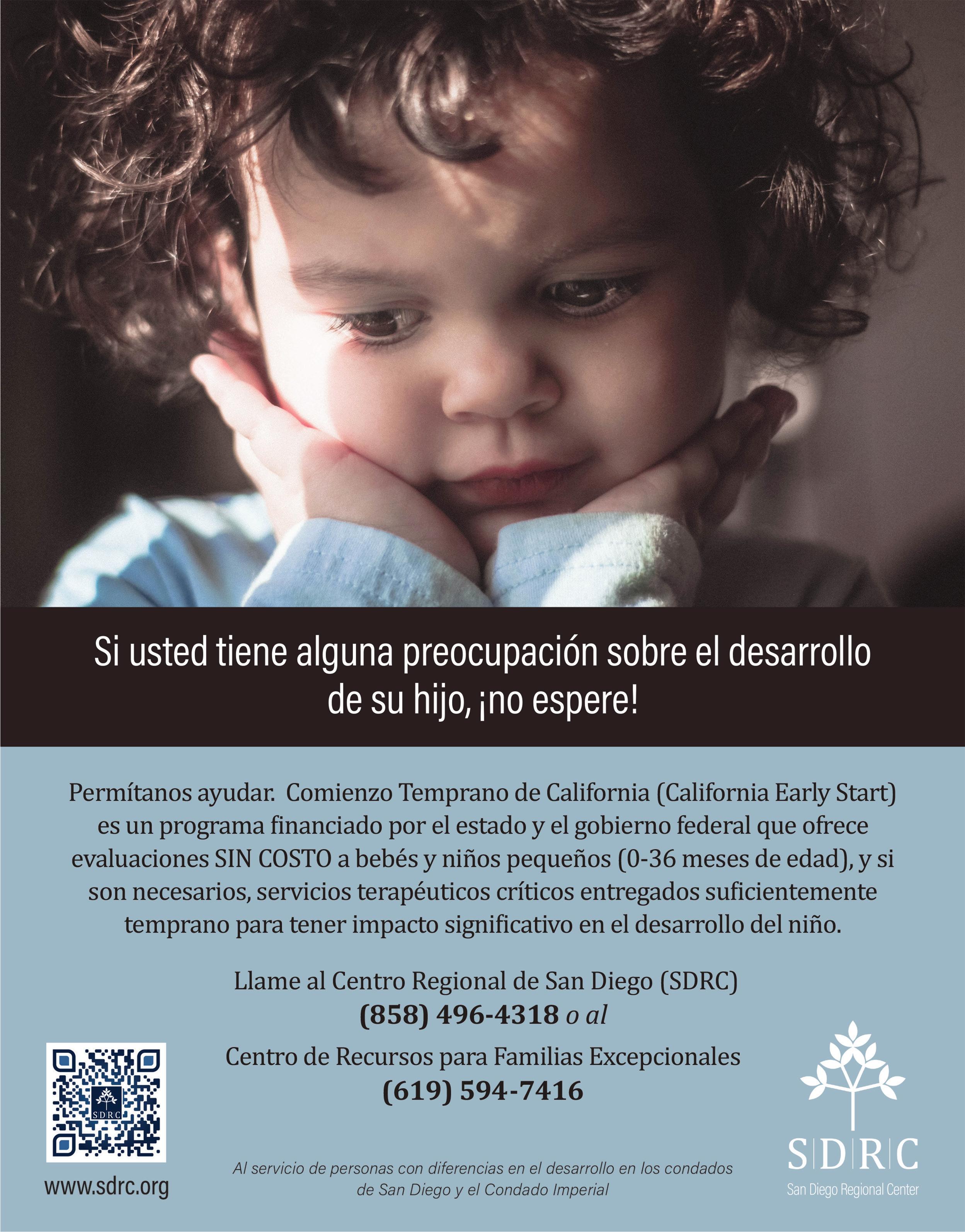
- Legal Assistance / Asistencia Legal
- Job & Clothing Assistance / Ayuda con empleo y vestimenta
- Pet Assistance / Ayuda con mascotas
Mano a Mano Foundation
Dra. Villarreal
1 (760) 492-8897
Apoyo y educación para la comunidad latina
En español
Pláticas gratis con jóvenes, familias Temas de drogas, disciplina, autoestima, violencia, bullying y más.
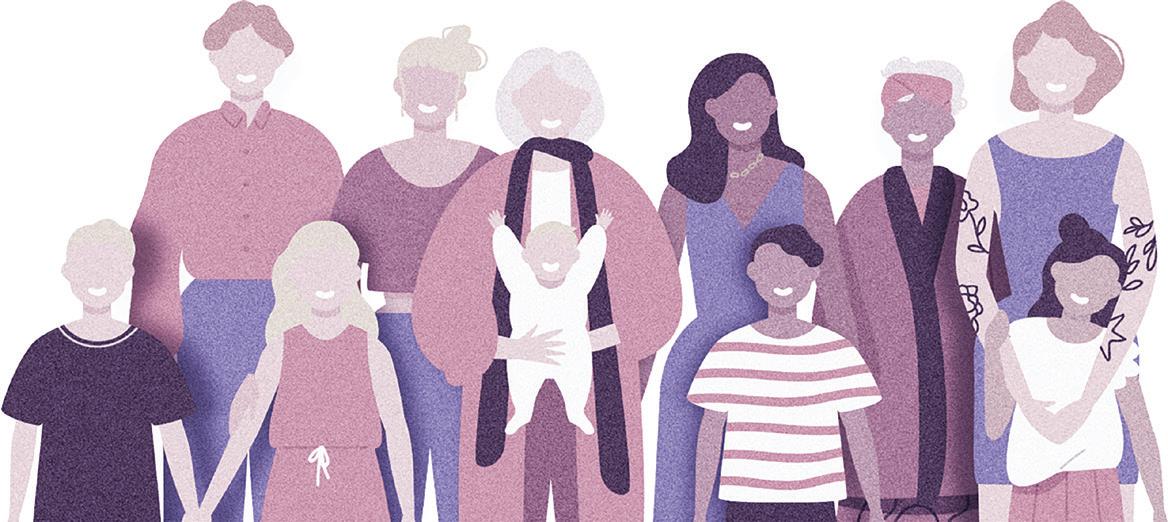
LEGAL RESOURCES Recursos legales
Ana Serrano, Las Valientes 760-439-1133
English y se habla español
1er y 3er miércoles de cada mes, 11 a 12:30
Iglesia del Señor Jesucristo en las Américas San Marcos
332 E. Olive St, San Marcos, CA 92069
Oceanside
- 2nd and 4th Tuesday of every month from 11am to 12pm
- 2do y 4to martes de cada mes, 11–12
Melba Bishop Community Recreation Center 5306 N River Rd, Oceanside, CA 92057
- More food distribution locations
- Más lugares de distribución de alimentos:
CALIFORNIA CONECTADA
Asistencia gratis para que usted pueda conectarse a Internet y: Encontrar servicios de Internet y dispositivos de bajo costo para su hogar

Aprender a navegar por Internet Buscar y utilizar recursos en línea para mejorar su vida y su profesión
CONNECTED CALIFORNIA
Free assistance so you can connect to the Internet and:
Find low-cost internet service and devices for your home
Learn how to navigate the internet Find and use online resources to improve your life and career
Llame / Call: 1-800-790-5319
Text message: 626-873-8396
email: ayuda@connectedca. libanswers.com
22 SEPTEMBER 2023 WWW.NORTHCOUNTYINFORMADOR.COM


















































